

Compact Muon Solenoid
LHC, CERN
| CMS-PAS-SUS-16-017 | ||
| Inclusive search for supersymmetry using razor variables in pp collisions at $\sqrt{s}= $ 13 TeV | ||
| CMS Collaboration | ||
| September 2018 | ||
| Abstract: An inclusive search for supersymmetry with the razor variables is performed using a data sample of proton-proton collisions corresponding to an integrated luminosity of 35.9 fb$^{-1}$ collected with the CMS experiment in 2016 at a center-of-mass energy of $\sqrt{s}= $ 13 TeV. The search covers final states with zero or one charged lepton and features event categories divided according to the presence of a high-transverse momentum hadronically decaying W boson or top quark, the number of jets, the number of b-tagged jets, and the values of the razor kinematic variables in order to separate signal from background for a wide variety of supersymmetric particle signatures. The combination of the zero-lepton, one-lepton, and boosted W boson and top quark event categories increases the sensitivity particularly to signal models with large mass splitting between the produced gluino or squark and the lightest supersymmetric particle. Limits on the gluino mass extend to 2.0 TeV while limits on top squark masses reach 1.14 TeV. | ||
|
Links:
CDS record (PDF) ;
CADI line (restricted) ;
These preliminary results are superseded in this paper, JHEP 03 (2019) 031. The superseded preliminary plots can be found here. |
||
| Figures | |
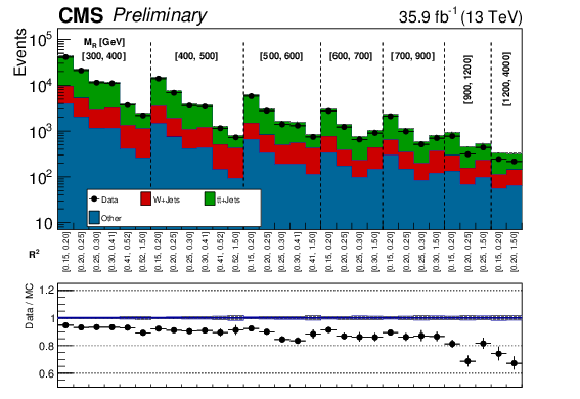
png pdf |
Figure 1:
The $ {M_\mathrm {R}} $-$ {\mathrm {R}^2} $ distribution observed in data is shown along with the MC prediction in the $ {{\mathrm {t}\overline {\mathrm {t}}}} $ one-lepton control region. The two-dimensional $ {M_\mathrm {R}} $-$ {\mathrm {R}^2} $ distribution is shown in a one dimensional representation, with each $ {M_\mathrm {R}} $ bin marked by the dashed lines and labeled near the top, and each $ {\mathrm {R}^2} $ bin labeled below. The ratio of data to the MC simulation prediction is shown on the bottom inset, with the statistical uncertainty expressed through the data point error bars and the systematic uncertainty of the background prediction represented by the shaded region. The corrections derived from background control regions have not been applied yet. |
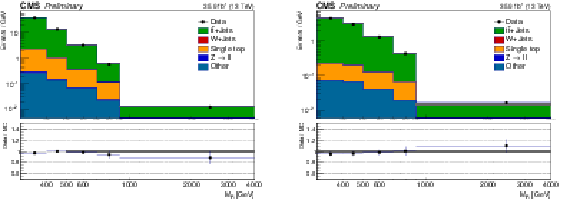
png pdf |
Figure 2:
The $ {M_\mathrm {R}} $ distribution in the $ {{\mathrm {t}\overline {\mathrm {t}}}} $ dilepton control region is displayed in the 2-3 and 4-6 jet categories along with the corresponding MC predictions. The corrections derived from the $ {{\mathrm {t}\overline {\mathrm {t}}}} $ and $ {\mathrm {W}}$+jets control regions have been applied. |

png pdf |
Figure 2-a:
The $ {M_\mathrm {R}} $ distribution in the $ {{\mathrm {t}\overline {\mathrm {t}}}} $ dilepton control region is displayed in the 2-3 and 4-6 jet categories along with the corresponding MC predictions. The corrections derived from the $ {{\mathrm {t}\overline {\mathrm {t}}}} $ and $ {\mathrm {W}}$+jets control regions have been applied. |

png pdf |
Figure 2-b:
The $ {M_\mathrm {R}} $ distribution in the $ {{\mathrm {t}\overline {\mathrm {t}}}} $ dilepton control region is displayed in the 2-3 and 4-6 jet categories along with the corresponding MC predictions. The corrections derived from the $ {{\mathrm {t}\overline {\mathrm {t}}}} $ and $ {\mathrm {W}}$+jets control regions have been applied. |
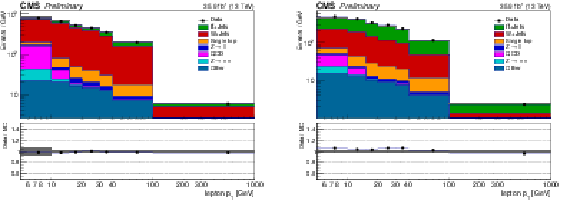
png pdf |
Figure 3:
The $ {p_{\mathrm {T}}} $ distribution for leptons passing the veto identification criteria is displayed in the 2-3 and 4-6 jet categories along with the corresponding MC predictions. The corrections derived from the $ {{\mathrm {t}\overline {\mathrm {t}}}} $ and $ {\mathrm {W}}$+jets control regions have been applied. |
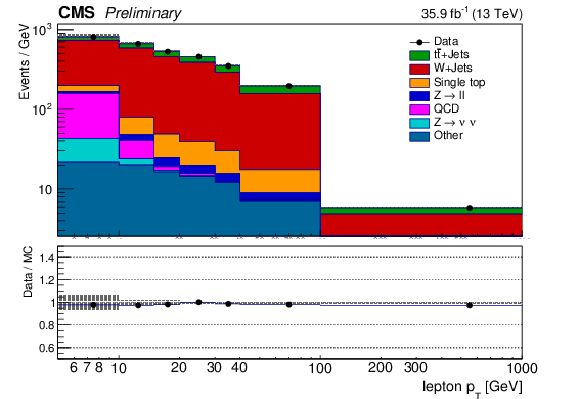
png pdf |
Figure 3-a:
The $ {p_{\mathrm {T}}} $ distribution for leptons passing the veto identification criteria is displayed in the 2-3 and 4-6 jet categories along with the corresponding MC predictions. The corrections derived from the $ {{\mathrm {t}\overline {\mathrm {t}}}} $ and $ {\mathrm {W}}$+jets control regions have been applied. |

png pdf |
Figure 3-b:
The $ {p_{\mathrm {T}}} $ distribution for leptons passing the veto identification criteria is displayed in the 2-3 and 4-6 jet categories along with the corresponding MC predictions. The corrections derived from the $ {{\mathrm {t}\overline {\mathrm {t}}}} $ and $ {\mathrm {W}}$+jets control regions have been applied. |

png pdf |
Figure 4:
The $ {M_\mathrm {R}} $-$ {\mathrm {R}^2} $ distribution observed in data is shown along with the MC prediction in the photon+jets control region. The two-dimensional $ {M_\mathrm {R}} $-$ {\mathrm {R}^2} $ distribution is shown in a one dimensional representation, with each $ {M_\mathrm {R}} $ bin marked by the dashed lines and labeled near the top, and each $ {\mathrm {R}^2} $ bin labeled below. The ratio of data to the background prediction is shown on the bottom inset, with the statistical uncertainty expressed through the data point error bars and the systematic uncertainty of the background prediction represented by the shaded region. The contribution from the $ {\gamma}$+jets process where the photon was produced from a jet fragmentation is labeled as "$ {\gamma}$+jets (frag.)''. The corrections derived from background control regions have not been applied yet in this figure. |
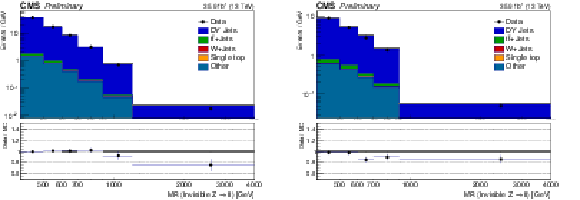
png pdf |
Figure 5:
The $ {M_\mathrm {R}} $ distribution in the Drell-Yan(DY)+jets dilepton control region is displayed in the 2-3 and 4-6 jet categories along with the corresponding MC predictions. The corrections derived from the $ {\gamma}$+jets control region as well as the overall normalization correction have been applied in this figure. |
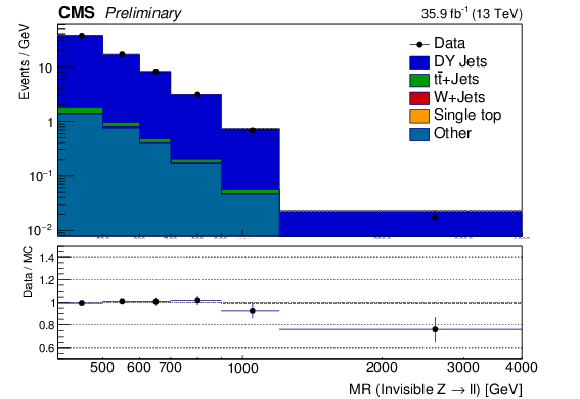
png pdf |
Figure 5-a:
The $ {M_\mathrm {R}} $ distribution in the Drell-Yan(DY)+jets dilepton control region is displayed in the 2-3 and 4-6 jet categories along with the corresponding MC predictions. The corrections derived from the $ {\gamma}$+jets control region as well as the overall normalization correction have been applied in this figure. |
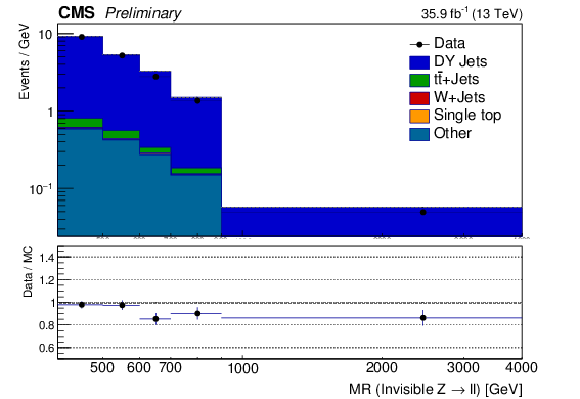
png pdf |
Figure 5-b:
The $ {M_\mathrm {R}} $ distribution in the Drell-Yan(DY)+jets dilepton control region is displayed in the 2-3 and 4-6 jet categories along with the corresponding MC predictions. The corrections derived from the $ {\gamma}$+jets control region as well as the overall normalization correction have been applied in this figure. |
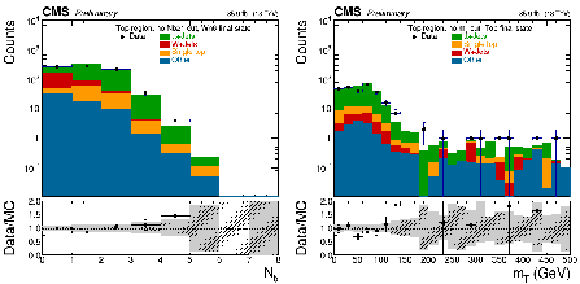
png pdf |
Figure 6:
Distributions of b-tagged jet multiplicity before applying the b-tagging selection requirement in the $ {\mathrm {W}}$+jets control region of the boosted Wnj6 category (left), and distributions in $M_{\mathrm {T}}$ before applying the $M_{\mathrm {T}}$ selection requirement in the top quark control region of the boosted Top category (right) are shown. The ratio of data over MC prediction is shown in the lower panels, where the gray band is the total uncertainty and the dashed band is the statistical uncertainty in the MC prediction. |
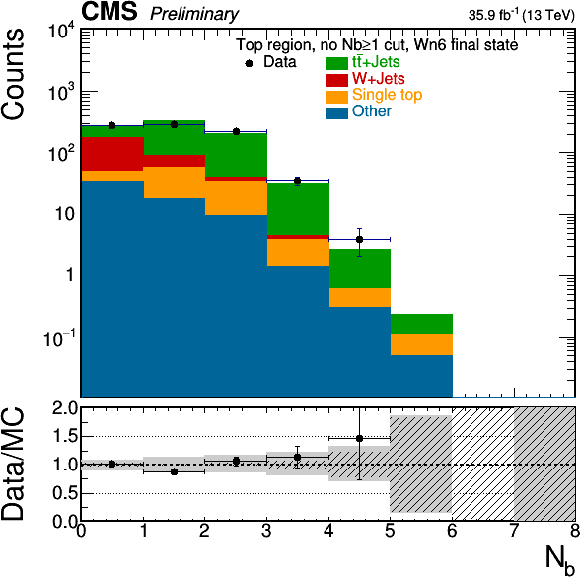
png |
Figure 6-a:
Distributions of b-tagged jet multiplicity before applying the b-tagging selection requirement in the $ {\mathrm {W}}$+jets control region of the boosted Wnj6 category (left), and distributions in $M_{\mathrm {T}}$ before applying the $M_{\mathrm {T}}$ selection requirement in the top quark control region of the boosted Top category (right) are shown. The ratio of data over MC prediction is shown in the lower panels, where the gray band is the total uncertainty and the dashed band is the statistical uncertainty in the MC prediction. |
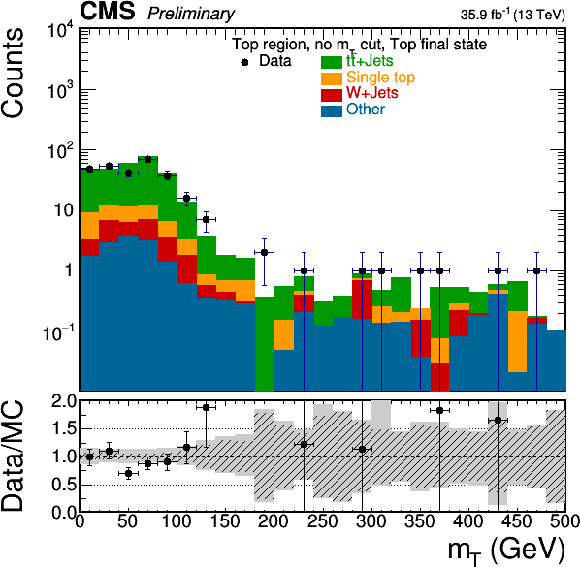
png |
Figure 6-b:
Distributions of b-tagged jet multiplicity before applying the b-tagging selection requirement in the $ {\mathrm {W}}$+jets control region of the boosted Wnj6 category (left), and distributions in $M_{\mathrm {T}}$ before applying the $M_{\mathrm {T}}$ selection requirement in the top quark control region of the boosted Top category (right) are shown. The ratio of data over MC prediction is shown in the lower panels, where the gray band is the total uncertainty and the dashed band is the statistical uncertainty in the MC prediction. |
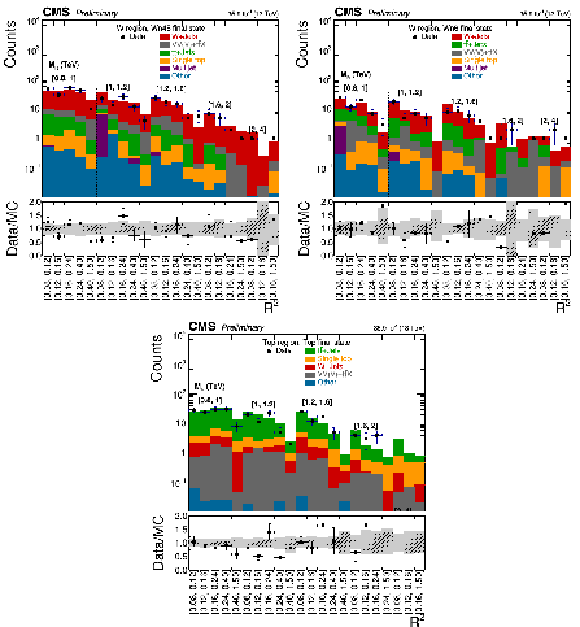
png pdf |
Figure 7:
$ {M_\mathrm {R}} $-$ {\mathrm {R}^2} $ distributions in the $ {\mathrm {W}}$+jets control regions of the boosted Wnj45 and Wnj6 categories, and the top quark control region of the Top category. The ratio of data over MC prediction is shown in the lower panels, where the gray band is the total uncertainty and the dashed band is the statistical uncertainty in the MC prediction. |
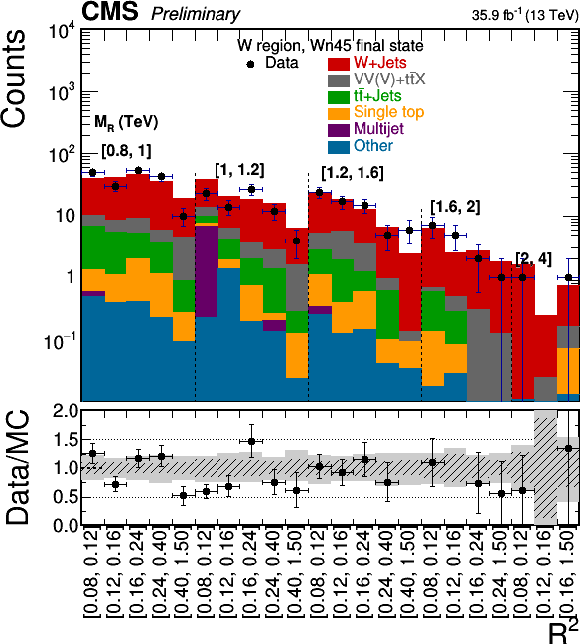
png |
Figure 7-a:
$ {M_\mathrm {R}} $-$ {\mathrm {R}^2} $ distributions in the $ {\mathrm {W}}$+jets control regions of the boosted Wnj45 and Wnj6 categories, and the top quark control region of the Top category. The ratio of data over MC prediction is shown in the lower panels, where the gray band is the total uncertainty and the dashed band is the statistical uncertainty in the MC prediction. |
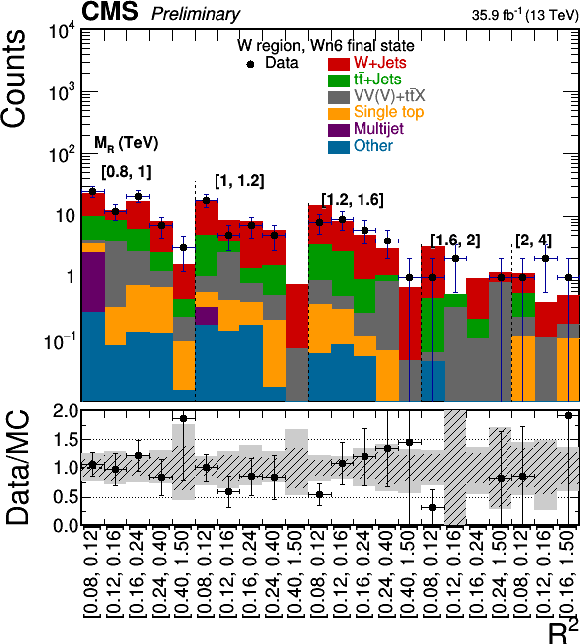
png |
Figure 7-b:
$ {M_\mathrm {R}} $-$ {\mathrm {R}^2} $ distributions in the $ {\mathrm {W}}$+jets control regions of the boosted Wnj45 and Wnj6 categories, and the top quark control region of the Top category. The ratio of data over MC prediction is shown in the lower panels, where the gray band is the total uncertainty and the dashed band is the statistical uncertainty in the MC prediction. |
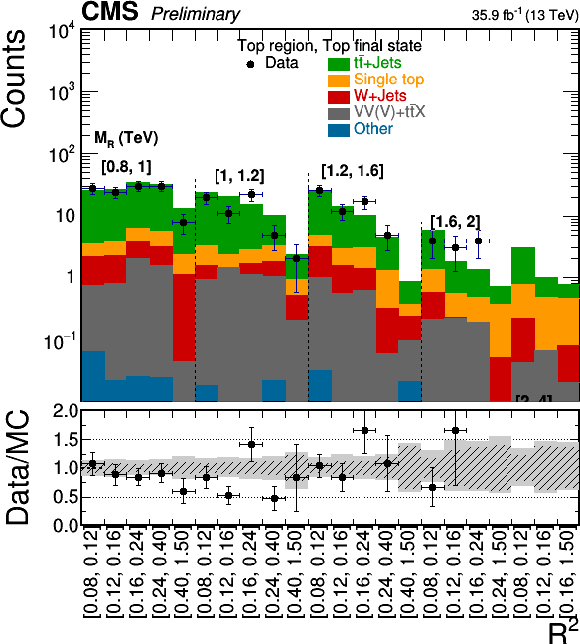
png |
Figure 7-c:
$ {M_\mathrm {R}} $-$ {\mathrm {R}^2} $ distributions in the $ {\mathrm {W}}$+jets control regions of the boosted Wnj45 and Wnj6 categories, and the top quark control region of the Top category. The ratio of data over MC prediction is shown in the lower panels, where the gray band is the total uncertainty and the dashed band is the statistical uncertainty in the MC prediction. |
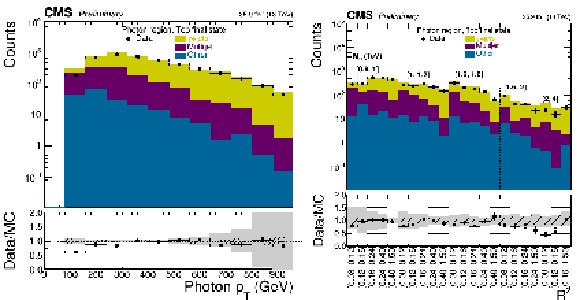
png pdf |
Figure 8:
Photon $ {p_{\mathrm {T}}} $ and $ {M_\mathrm {R}} $-$ {\mathrm {R}^2} $ distributions for the $ {\gamma}$+jets control regions of the boosted Top category. The ratio of data over MC prediction is shown in the lower panels, where the gray band is the total uncertainty and the dashed band is the statistical uncertainty in the MC prediction. |
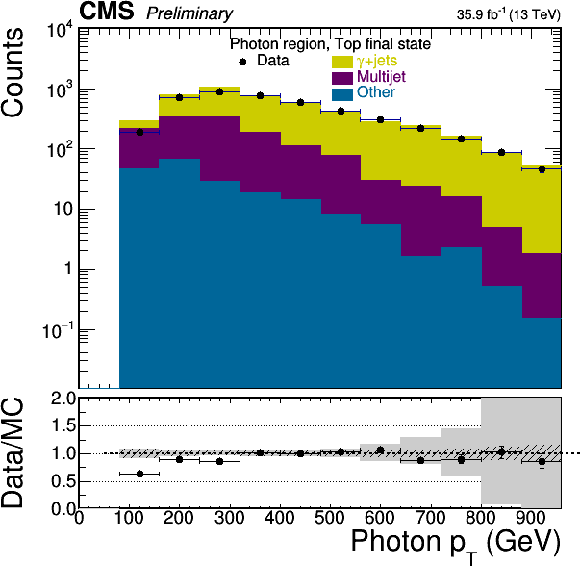
png |
Figure 8-a:
Photon $ {p_{\mathrm {T}}} $ and $ {M_\mathrm {R}} $-$ {\mathrm {R}^2} $ distributions for the $ {\gamma}$+jets control regions of the boosted Top category. The ratio of data over MC prediction is shown in the lower panels, where the gray band is the total uncertainty and the dashed band is the statistical uncertainty in the MC prediction. |

png |
Figure 8-b:
Photon $ {p_{\mathrm {T}}} $ and $ {M_\mathrm {R}} $-$ {\mathrm {R}^2} $ distributions for the $ {\gamma}$+jets control regions of the boosted Top category. The ratio of data over MC prediction is shown in the lower panels, where the gray band is the total uncertainty and the dashed band is the statistical uncertainty in the MC prediction. |
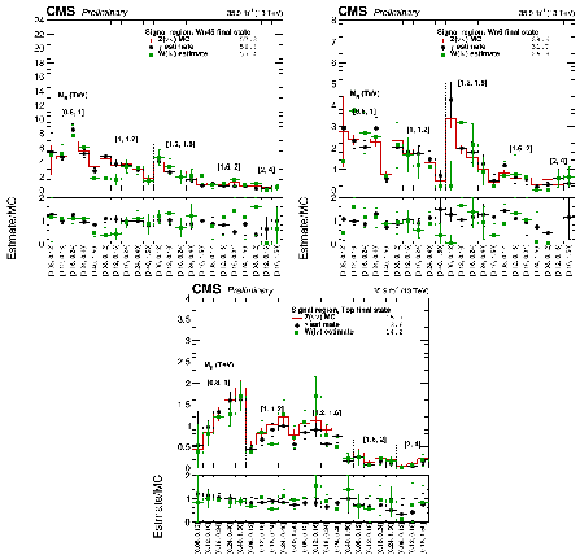
png pdf |
Figure 9:
Comparison of the estimation of the $\mathrm{Z}(\rightarrow \nu \nu)+$jets background contribution in the search region extrapolated from the $ {\gamma}$+jets control region with the estimation extrapolated from the $\mathrm{W}(\rightarrow \ell \nu)$+jets control region for the boosted Wnj45, Wnj6 and Top categories. The prediction from the uncorrected MC simulation is also shown. |
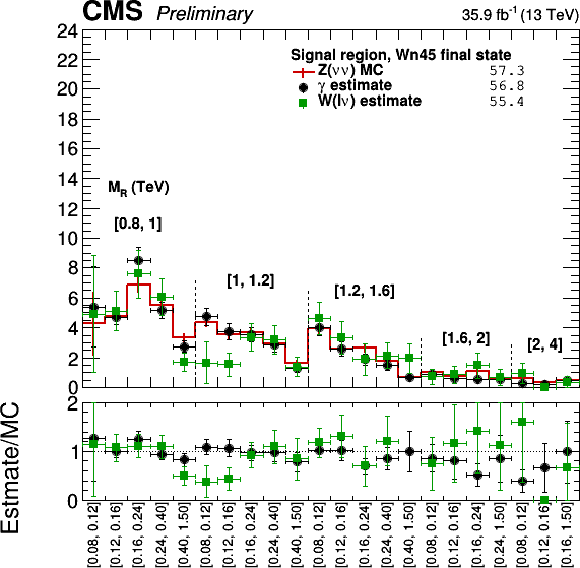
png |
Figure 9-a:
Comparison of the estimation of the $\mathrm{Z}(\rightarrow \nu \nu)+$jets background contribution in the search region extrapolated from the $ {\gamma}$+jets control region with the estimation extrapolated from the $\mathrm{W}(\rightarrow \ell \nu)$+jets control region for the boosted Wnj45, Wnj6 and Top categories. The prediction from the uncorrected MC simulation is also shown. |
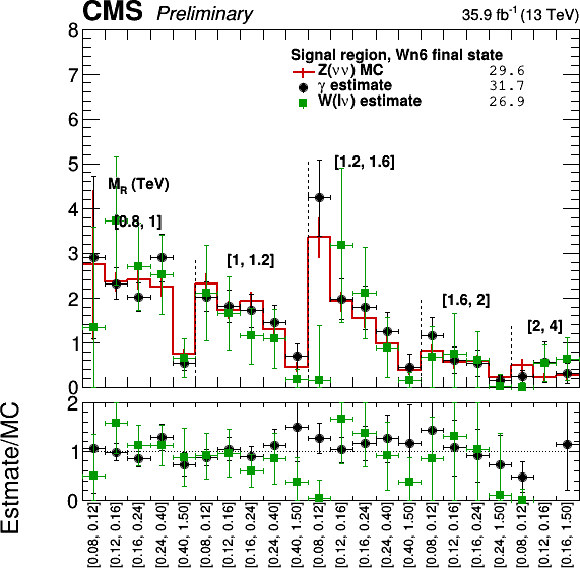
png |
Figure 9-b:
Comparison of the estimation of the $\mathrm{Z}(\rightarrow \nu \nu)+$jets background contribution in the search region extrapolated from the $ {\gamma}$+jets control region with the estimation extrapolated from the $\mathrm{W}(\rightarrow \ell \nu)$+jets control region for the boosted Wnj45, Wnj6 and Top categories. The prediction from the uncorrected MC simulation is also shown. |
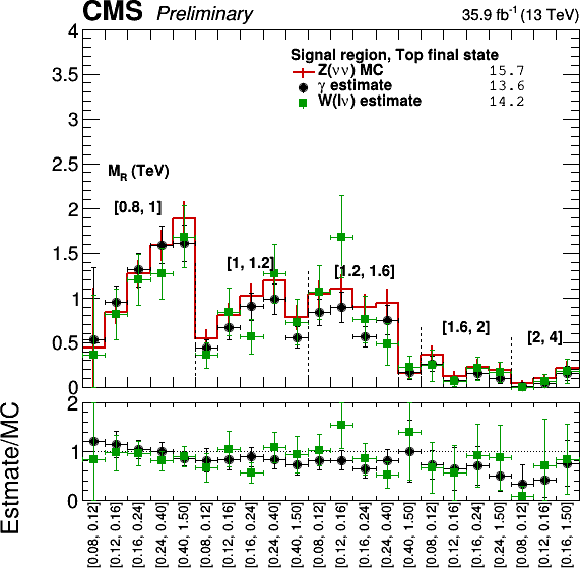
png |
Figure 9-c:
Comparison of the estimation of the $\mathrm{Z}(\rightarrow \nu \nu)+$jets background contribution in the search region extrapolated from the $ {\gamma}$+jets control region with the estimation extrapolated from the $\mathrm{W}(\rightarrow \ell \nu)$+jets control region for the boosted Wnj45, Wnj6 and Top categories. The prediction from the uncorrected MC simulation is also shown. |

png pdf |
Figure 10:
$ {M_\mathrm {R}} $-$ {\mathrm {R}^2} $ distributions in the QCD multijet control regions of the Wnj45 (upper left), Wnj6 (upper right) and Top (bottom) categories. The ratio of data over MC prediction is shown in the lower panels, where the gray band is the total uncertainty and the dashed band is the statistical uncertainty on the MC prediction. |
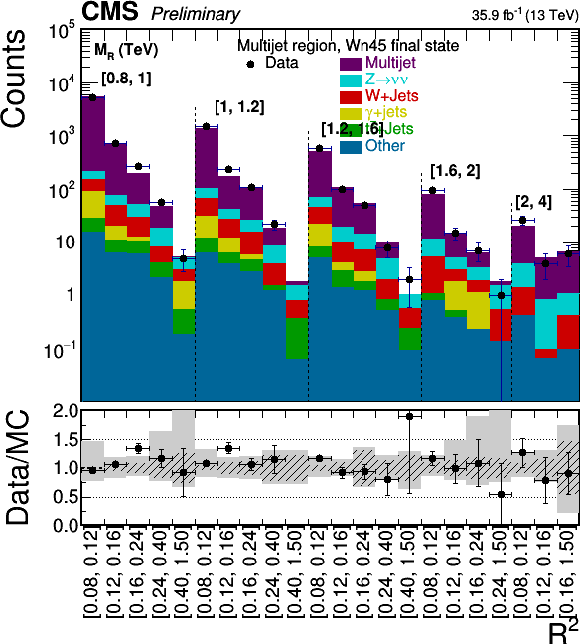
png |
Figure 10-a:
$ {M_\mathrm {R}} $-$ {\mathrm {R}^2} $ distributions in the QCD multijet control regions of the Wnj45 (upper left), Wnj6 (upper right) and Top (bottom) categories. The ratio of data over MC prediction is shown in the lower panels, where the gray band is the total uncertainty and the dashed band is the statistical uncertainty on the MC prediction. |
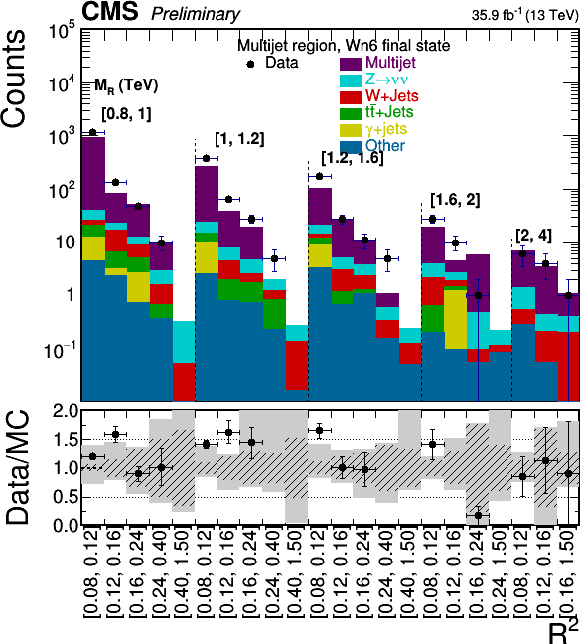
png |
Figure 10-b:
$ {M_\mathrm {R}} $-$ {\mathrm {R}^2} $ distributions in the QCD multijet control regions of the Wnj45 (upper left), Wnj6 (upper right) and Top (bottom) categories. The ratio of data over MC prediction is shown in the lower panels, where the gray band is the total uncertainty and the dashed band is the statistical uncertainty on the MC prediction. |

png |
Figure 10-c:
$ {M_\mathrm {R}} $-$ {\mathrm {R}^2} $ distributions in the QCD multijet control regions of the Wnj45 (upper left), Wnj6 (upper right) and Top (bottom) categories. The ratio of data over MC prediction is shown in the lower panels, where the gray band is the total uncertainty and the dashed band is the statistical uncertainty on the MC prediction. |
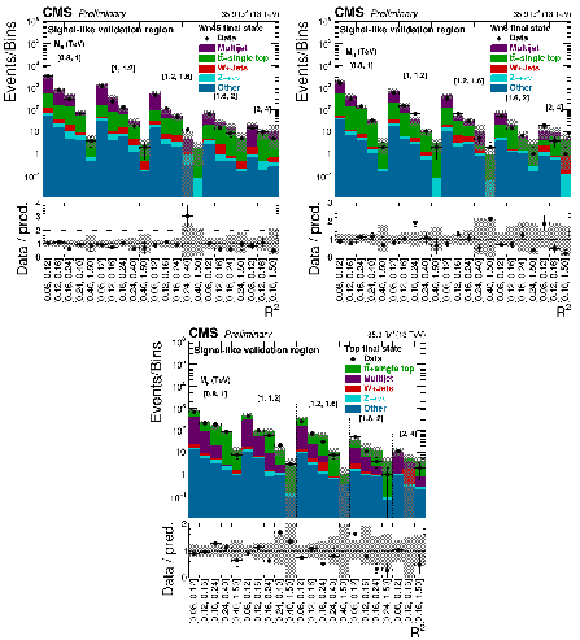
png pdf |
Figure 11:
Comparisons between data and the predicted background for the inverted $ {\Delta \phi _\mathrm {R}} $ validation region for the boosted Wnj45 (upper left), Wnj6 (upper right) and Top (bottom) categories. |
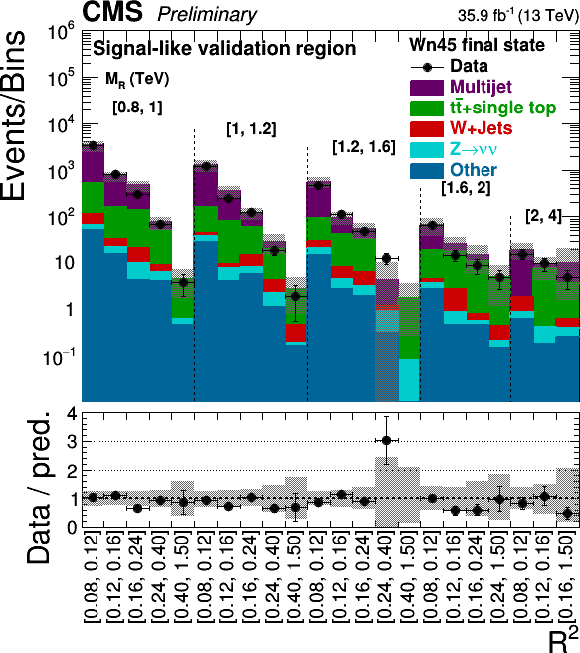
png |
Figure 11-a:
Comparisons between data and the predicted background for the inverted $ {\Delta \phi _\mathrm {R}} $ validation region for the boosted Wnj45 (upper left), Wnj6 (upper right) and Top (bottom) categories. |

png |
Figure 11-b:
Comparisons between data and the predicted background for the inverted $ {\Delta \phi _\mathrm {R}} $ validation region for the boosted Wnj45 (upper left), Wnj6 (upper right) and Top (bottom) categories. |
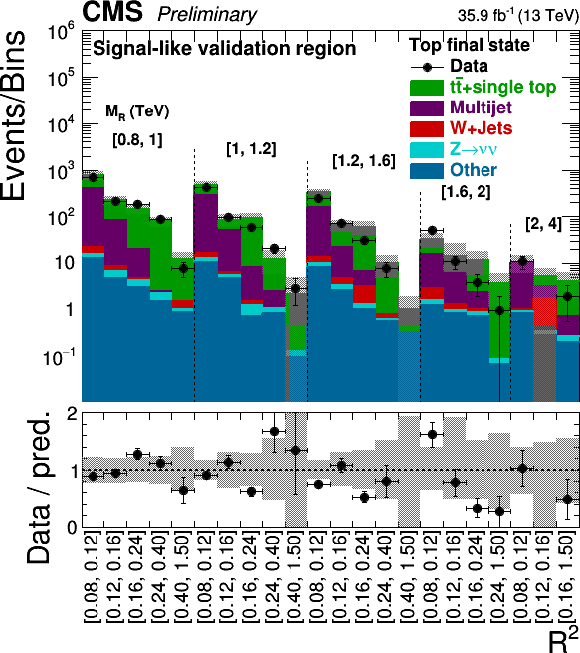
png |
Figure 11-c:
Comparisons between data and the predicted background for the inverted $ {\Delta \phi _\mathrm {R}} $ validation region for the boosted Wnj45 (upper left), Wnj6 (upper right) and Top (bottom) categories. |
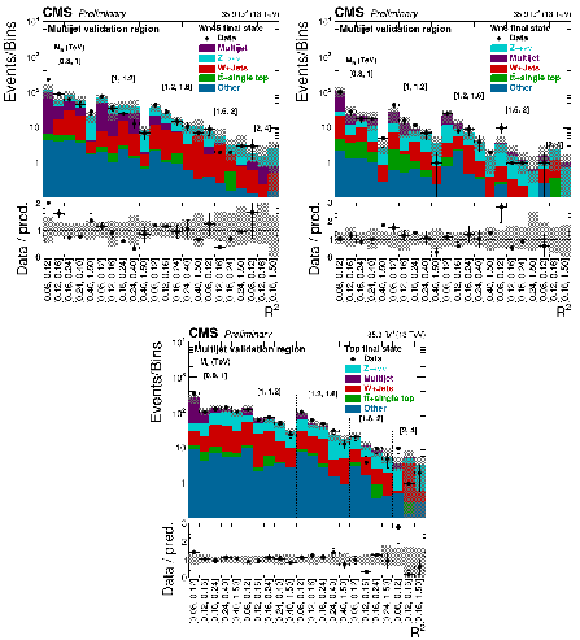
png pdf |
Figure 12:
Comparisons between data and the predicted background for the validation region with anti-tagged W boson or top quark candidates for the boosted Wnj45 (upper left), Wnj6 (upper right) and Top (bottom) categories. |

png |
Figure 12-a:
Comparisons between data and the predicted background for the validation region with anti-tagged W boson or top quark candidates for the boosted Wnj45 (upper left), Wnj6 (upper right) and Top (bottom) categories. |

png |
Figure 12-b:
Comparisons between data and the predicted background for the validation region with anti-tagged W boson or top quark candidates for the boosted Wnj45 (upper left), Wnj6 (upper right) and Top (bottom) categories. |
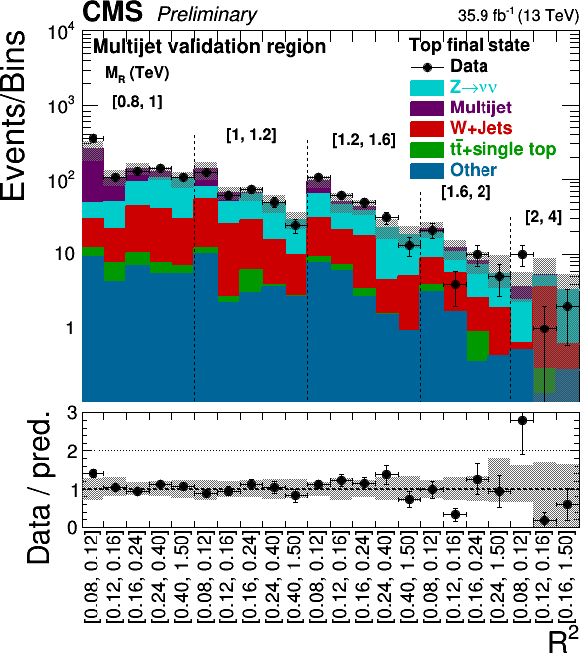
png |
Figure 12-c:
Comparisons between data and the predicted background for the validation region with anti-tagged W boson or top quark candidates for the boosted Wnj45 (upper left), Wnj6 (upper right) and Top (bottom) categories. |

png pdf |
Figure 13:
The $ {M_\mathrm {R}} $-$ {\mathrm {R}^2} $ distribution observed in data is shown along with the background prediction obtained for the Lepton Multijet event category in the 0 b-tag (top) and 1 b-tag (bottom) bins. The two-dimensional $ {M_\mathrm {R}} $-$ {\mathrm {R}^2} $ distribution is shown in a one dimensional representation, with each $ {M_\mathrm {R}} $ bin marked by the dashed lines and labeled near the top, and each $ {\mathrm {R}^2} $ bin labeled below. The ratio of data to the background prediction is shown on the bottom inset, with the statistical uncertainty expressed through the data point error bars and the systematic uncertainty of the background prediction represented by the shaded region. Signal benchmarks shown are T5ttcc with $m_{\tilde{\mathrm{g}}} = $ 1.4 TeV, $m_{\tilde{\mathrm{t}}} = $ 320 GeV and $m_{\tilde{\chi}_1^0} = $ 300 GeV; T1tttt with $m_{\tilde{\mathrm{g}}} = $ 1.4 TeV and $m_{\tilde{\chi}_1^0} = $ 300 GeV; and T2tt with $m_{\tilde{\mathrm{t}}} = $ 850 GeV and $m_{\tilde{\chi}_1^0} = $ 100 GeV. The diagrams corresponding to these signal models are shown in Figure xxxxx. |

png pdf |
Figure 13-a:
The $ {M_\mathrm {R}} $-$ {\mathrm {R}^2} $ distribution observed in data is shown along with the background prediction obtained for the Lepton Multijet event category in the 0 b-tag (top) and 1 b-tag (bottom) bins. The two-dimensional $ {M_\mathrm {R}} $-$ {\mathrm {R}^2} $ distribution is shown in a one dimensional representation, with each $ {M_\mathrm {R}} $ bin marked by the dashed lines and labeled near the top, and each $ {\mathrm {R}^2} $ bin labeled below. The ratio of data to the background prediction is shown on the bottom inset, with the statistical uncertainty expressed through the data point error bars and the systematic uncertainty of the background prediction represented by the shaded region. Signal benchmarks shown are T5ttcc with $m_{\tilde{\mathrm{g}}} = $ 1.4 TeV, $m_{\tilde{\mathrm{t}}} = $ 320 GeV and $m_{\tilde{\chi}_1^0} = $ 300 GeV; T1tttt with $m_{\tilde{\mathrm{g}}} = $ 1.4 TeV and $m_{\tilde{\chi}_1^0} = $ 300 GeV; and T2tt with $m_{\tilde{\mathrm{t}}} = $ 850 GeV and $m_{\tilde{\chi}_1^0} = $ 100 GeV. The diagrams corresponding to these signal models are shown in Figure xxxxx.-a |
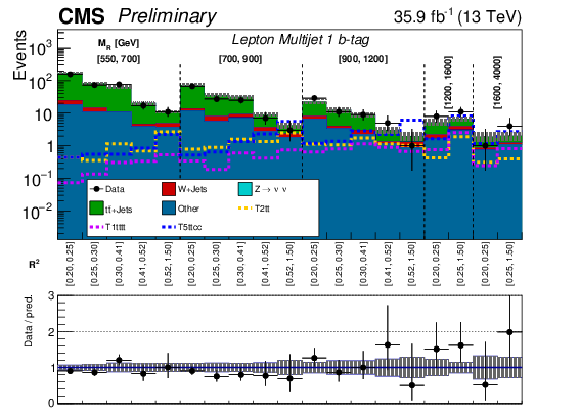
png pdf |
Figure 13-b:
The $ {M_\mathrm {R}} $-$ {\mathrm {R}^2} $ distribution observed in data is shown along with the background prediction obtained for the Lepton Multijet event category in the 0 b-tag (top) and 1 b-tag (bottom) bins. The two-dimensional $ {M_\mathrm {R}} $-$ {\mathrm {R}^2} $ distribution is shown in a one dimensional representation, with each $ {M_\mathrm {R}} $ bin marked by the dashed lines and labeled near the top, and each $ {\mathrm {R}^2} $ bin labeled below. The ratio of data to the background prediction is shown on the bottom inset, with the statistical uncertainty expressed through the data point error bars and the systematic uncertainty of the background prediction represented by the shaded region. Signal benchmarks shown are T5ttcc with $m_{\tilde{\mathrm{g}}} = $ 1.4 TeV, $m_{\tilde{\mathrm{t}}} = $ 320 GeV and $m_{\tilde{\chi}_1^0} = $ 300 GeV; T1tttt with $m_{\tilde{\mathrm{g}}} = $ 1.4 TeV and $m_{\tilde{\chi}_1^0} = $ 300 GeV; and T2tt with $m_{\tilde{\mathrm{t}}} = $ 850 GeV and $m_{\tilde{\chi}_1^0} = $ 100 GeV. The diagrams corresponding to these signal models are shown in Figure xxxxx.-b |

png pdf |
Figure 14:
The $ {M_\mathrm {R}} $-$ {\mathrm {R}^2} $ distribution observed in data is shown along with the background prediction obtained for the Lepton Multijet event category in the 2 b-tag (top) and 3 b-tag (bottom) bins. The two-dimensional $ {M_\mathrm {R}} $-$ {\mathrm {R}^2} $ distribution is shown in a one dimensional representation, with each $ {M_\mathrm {R}} $ bin marked by the dashed lines and labeled near the top, and each $ {\mathrm {R}^2} $ bin labeled below. The ratio of data to the background prediction is shown on the bottom inset, with the statistical uncertainty expressed through the data point error bars and the systematic uncertainty of the background prediction represented by the shaded region. Signal benchmarks shown are T5ttcc with $m_{\tilde{\mathrm{g}}} = $ 1.4 TeV, $m_{\tilde{\mathrm{t}}} = $ 320 GeV and $m_{\tilde{\chi}_1^0} = $ 300 GeV; T1tttt with $m_{\tilde{\mathrm{g}}} = $ 1.4 TeV and $m_{\tilde{\chi}_1^0} = $ 300 GeV; and T2tt with $m_{\tilde{\mathrm{t}}} = $ 850 GeV and $m_{\tilde{\chi}_1^0} = $ 100 GeV. The diagrams corresponding to these signal models are shown in Figure xxxxx. |

png pdf |
Figure 14-a:
The $ {M_\mathrm {R}} $-$ {\mathrm {R}^2} $ distribution observed in data is shown along with the background prediction obtained for the Lepton Multijet event category in the 2 b-tag (top) and 3 b-tag (bottom) bins. The two-dimensional $ {M_\mathrm {R}} $-$ {\mathrm {R}^2} $ distribution is shown in a one dimensional representation, with each $ {M_\mathrm {R}} $ bin marked by the dashed lines and labeled near the top, and each $ {\mathrm {R}^2} $ bin labeled below. The ratio of data to the background prediction is shown on the bottom inset, with the statistical uncertainty expressed through the data point error bars and the systematic uncertainty of the background prediction represented by the shaded region. Signal benchmarks shown are T5ttcc with $m_{\tilde{\mathrm{g}}} = $ 1.4 TeV, $m_{\tilde{\mathrm{t}}} = $ 320 GeV and $m_{\tilde{\chi}_1^0} = $ 300 GeV; T1tttt with $m_{\tilde{\mathrm{g}}} = $ 1.4 TeV and $m_{\tilde{\chi}_1^0} = $ 300 GeV; and T2tt with $m_{\tilde{\mathrm{t}}} = $ 850 GeV and $m_{\tilde{\chi}_1^0} = $ 100 GeV. The diagrams corresponding to these signal models are shown in Figure xxxxx.-a |
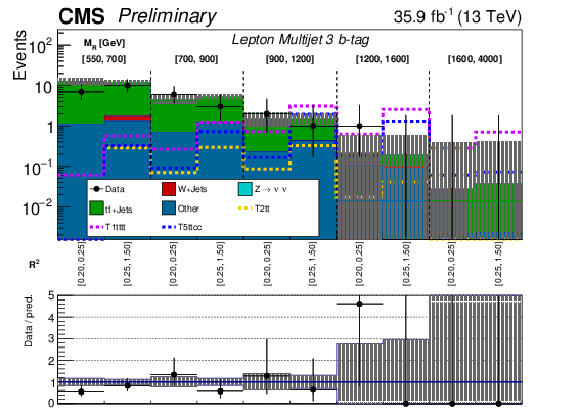
png pdf |
Figure 14-b:
The $ {M_\mathrm {R}} $-$ {\mathrm {R}^2} $ distribution observed in data is shown along with the background prediction obtained for the Lepton Multijet event category in the 2 b-tag (top) and 3 b-tag (bottom) bins. The two-dimensional $ {M_\mathrm {R}} $-$ {\mathrm {R}^2} $ distribution is shown in a one dimensional representation, with each $ {M_\mathrm {R}} $ bin marked by the dashed lines and labeled near the top, and each $ {\mathrm {R}^2} $ bin labeled below. The ratio of data to the background prediction is shown on the bottom inset, with the statistical uncertainty expressed through the data point error bars and the systematic uncertainty of the background prediction represented by the shaded region. Signal benchmarks shown are T5ttcc with $m_{\tilde{\mathrm{g}}} = $ 1.4 TeV, $m_{\tilde{\mathrm{t}}} = $ 320 GeV and $m_{\tilde{\chi}_1^0} = $ 300 GeV; T1tttt with $m_{\tilde{\mathrm{g}}} = $ 1.4 TeV and $m_{\tilde{\chi}_1^0} = $ 300 GeV; and T2tt with $m_{\tilde{\mathrm{t}}} = $ 850 GeV and $m_{\tilde{\chi}_1^0} = $ 100 GeV. The diagrams corresponding to these signal models are shown in Figure xxxxx.-b |

png pdf |
Figure 15:
The $ {M_\mathrm {R}} $-$ {\mathrm {R}^2} $ distribution observed in data is shown along with the background prediction obtained for the Lepton Seven-jet event category in the 0 b-tag (top) and 1 b-tag (bottom) bins. The two-dimensional $ {M_\mathrm {R}} $-$ {\mathrm {R}^2} $ distribution is shown in a one dimensional representation, with each $ {M_\mathrm {R}} $ bin marked by the dashed lines and labeled near the top, and each $ {\mathrm {R}^2} $ bin labeled below. The ratio of data to the background prediction is shown on the bottom inset, with the statistical uncertainty expressed through the data point error bars and the systematic uncertainty of the background prediction represented by the shaded region. Signal benchmarks shown are T5ttcc with $m_{\tilde{\mathrm{g}}} = $ 1.4 TeV, $m_{\tilde{\mathrm{t}}} = $ 320 GeV and $m_{\tilde{\chi}_1^0} = $ 300 GeV; T1tttt with $m_{\tilde{\mathrm{g}}} = $ 1.4 TeV and $m_{\tilde{\chi}_1^0} = $ 300 GeV; and T2tt with $m_{\tilde{\mathrm{t}}} = $ 850 GeV and $m_{\tilde{\chi}_1^0} = $ 100 GeV. The diagrams corresponding to these signal models are shown in Figure xxxxx. |

png pdf |
Figure 15-a:
The $ {M_\mathrm {R}} $-$ {\mathrm {R}^2} $ distribution observed in data is shown along with the background prediction obtained for the Lepton Seven-jet event category in the 0 b-tag (top) and 1 b-tag (bottom) bins. The two-dimensional $ {M_\mathrm {R}} $-$ {\mathrm {R}^2} $ distribution is shown in a one dimensional representation, with each $ {M_\mathrm {R}} $ bin marked by the dashed lines and labeled near the top, and each $ {\mathrm {R}^2} $ bin labeled below. The ratio of data to the background prediction is shown on the bottom inset, with the statistical uncertainty expressed through the data point error bars and the systematic uncertainty of the background prediction represented by the shaded region. Signal benchmarks shown are T5ttcc with $m_{\tilde{\mathrm{g}}} = $ 1.4 TeV, $m_{\tilde{\mathrm{t}}} = $ 320 GeV and $m_{\tilde{\chi}_1^0} = $ 300 GeV; T1tttt with $m_{\tilde{\mathrm{g}}} = $ 1.4 TeV and $m_{\tilde{\chi}_1^0} = $ 300 GeV; and T2tt with $m_{\tilde{\mathrm{t}}} = $ 850 GeV and $m_{\tilde{\chi}_1^0} = $ 100 GeV. The diagrams corresponding to these signal models are shown in Figure xxxxx.-a |
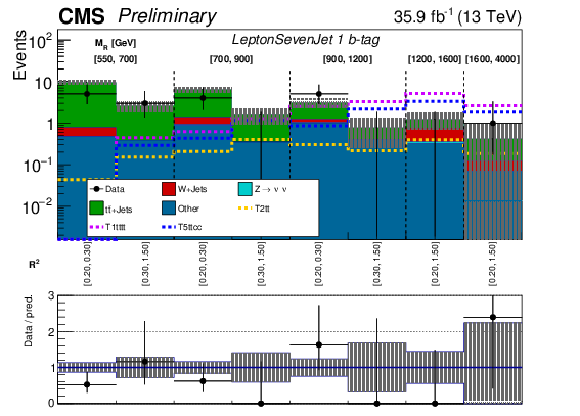
png pdf |
Figure 15-b:
The $ {M_\mathrm {R}} $-$ {\mathrm {R}^2} $ distribution observed in data is shown along with the background prediction obtained for the Lepton Seven-jet event category in the 0 b-tag (top) and 1 b-tag (bottom) bins. The two-dimensional $ {M_\mathrm {R}} $-$ {\mathrm {R}^2} $ distribution is shown in a one dimensional representation, with each $ {M_\mathrm {R}} $ bin marked by the dashed lines and labeled near the top, and each $ {\mathrm {R}^2} $ bin labeled below. The ratio of data to the background prediction is shown on the bottom inset, with the statistical uncertainty expressed through the data point error bars and the systematic uncertainty of the background prediction represented by the shaded region. Signal benchmarks shown are T5ttcc with $m_{\tilde{\mathrm{g}}} = $ 1.4 TeV, $m_{\tilde{\mathrm{t}}} = $ 320 GeV and $m_{\tilde{\chi}_1^0} = $ 300 GeV; T1tttt with $m_{\tilde{\mathrm{g}}} = $ 1.4 TeV and $m_{\tilde{\chi}_1^0} = $ 300 GeV; and T2tt with $m_{\tilde{\mathrm{t}}} = $ 850 GeV and $m_{\tilde{\chi}_1^0} = $ 100 GeV. The diagrams corresponding to these signal models are shown in Figure xxxxx.-b |
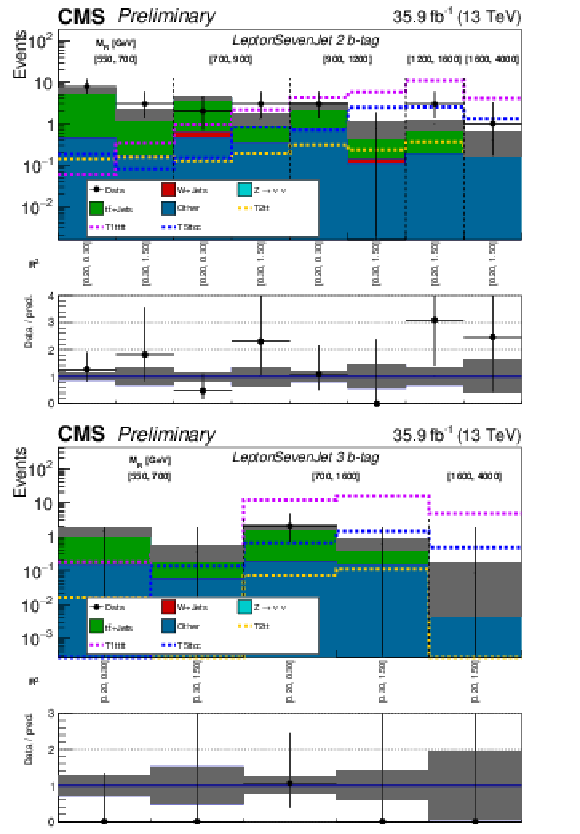
png pdf |
Figure 16:
The $ {M_\mathrm {R}} $-$ {\mathrm {R}^2} $ distribution observed in data is shown along with the background prediction obtained for the Lepton Seven-jet event category in the 2 b-tag (top) and 3 b-tag (bottom) bins. The two-dimensional $ {M_\mathrm {R}} $-$ {\mathrm {R}^2} $ distribution is shown in a one dimensional representation, with each $ {M_\mathrm {R}} $ bin marked by the dashed lines and labeled near the top, and each $ {\mathrm {R}^2} $ bin labeled below. The ratio of data to the background prediction is shown on the bottom inset, with the statistical uncertainty expressed through the data point error bars and the systematic uncertainty of the background prediction represented by the shaded region. Signal benchmarks shown are T5ttcc with $m_{\tilde{\mathrm{g}}} = $ 1.4 TeV, $m_{\tilde{\mathrm{t}}} = $ 320 GeV and $m_{\tilde{\chi}_1^0} = $ 300 GeV; T1tttt with $m_{\tilde{\mathrm{g}}} = $ 1.4 TeV and $m_{\tilde{\chi}_1^0} = $ 300 GeV; and T2tt with $m_{\tilde{\mathrm{t}}} = $ 850 GeV and $m_{\tilde{\chi}_1^0} = $ 100 GeV. The diagrams corresponding to these signal models are shown in Figure xxxxx. |
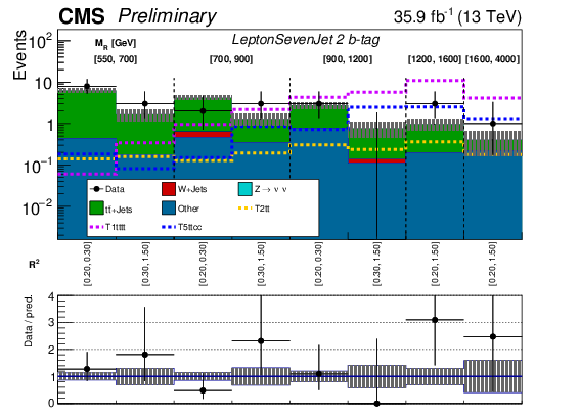
png pdf |
Figure 16-a:
The $ {M_\mathrm {R}} $-$ {\mathrm {R}^2} $ distribution observed in data is shown along with the background prediction obtained for the Lepton Seven-jet event category in the 2 b-tag (top) and 3 b-tag (bottom) bins. The two-dimensional $ {M_\mathrm {R}} $-$ {\mathrm {R}^2} $ distribution is shown in a one dimensional representation, with each $ {M_\mathrm {R}} $ bin marked by the dashed lines and labeled near the top, and each $ {\mathrm {R}^2} $ bin labeled below. The ratio of data to the background prediction is shown on the bottom inset, with the statistical uncertainty expressed through the data point error bars and the systematic uncertainty of the background prediction represented by the shaded region. Signal benchmarks shown are T5ttcc with $m_{\tilde{\mathrm{g}}} = $ 1.4 TeV, $m_{\tilde{\mathrm{t}}} = $ 320 GeV and $m_{\tilde{\chi}_1^0} = $ 300 GeV; T1tttt with $m_{\tilde{\mathrm{g}}} = $ 1.4 TeV and $m_{\tilde{\chi}_1^0} = $ 300 GeV; and T2tt with $m_{\tilde{\mathrm{t}}} = $ 850 GeV and $m_{\tilde{\chi}_1^0} = $ 100 GeV. The diagrams corresponding to these signal models are shown in Figure xxxxx.-a |

png pdf |
Figure 16-b:
The $ {M_\mathrm {R}} $-$ {\mathrm {R}^2} $ distribution observed in data is shown along with the background prediction obtained for the Lepton Seven-jet event category in the 2 b-tag (top) and 3 b-tag (bottom) bins. The two-dimensional $ {M_\mathrm {R}} $-$ {\mathrm {R}^2} $ distribution is shown in a one dimensional representation, with each $ {M_\mathrm {R}} $ bin marked by the dashed lines and labeled near the top, and each $ {\mathrm {R}^2} $ bin labeled below. The ratio of data to the background prediction is shown on the bottom inset, with the statistical uncertainty expressed through the data point error bars and the systematic uncertainty of the background prediction represented by the shaded region. Signal benchmarks shown are T5ttcc with $m_{\tilde{\mathrm{g}}} = $ 1.4 TeV, $m_{\tilde{\mathrm{t}}} = $ 320 GeV and $m_{\tilde{\chi}_1^0} = $ 300 GeV; T1tttt with $m_{\tilde{\mathrm{g}}} = $ 1.4 TeV and $m_{\tilde{\chi}_1^0} = $ 300 GeV; and T2tt with $m_{\tilde{\mathrm{t}}} = $ 850 GeV and $m_{\tilde{\chi}_1^0} = $ 100 GeV. The diagrams corresponding to these signal models are shown in Figure xxxxx.-b |
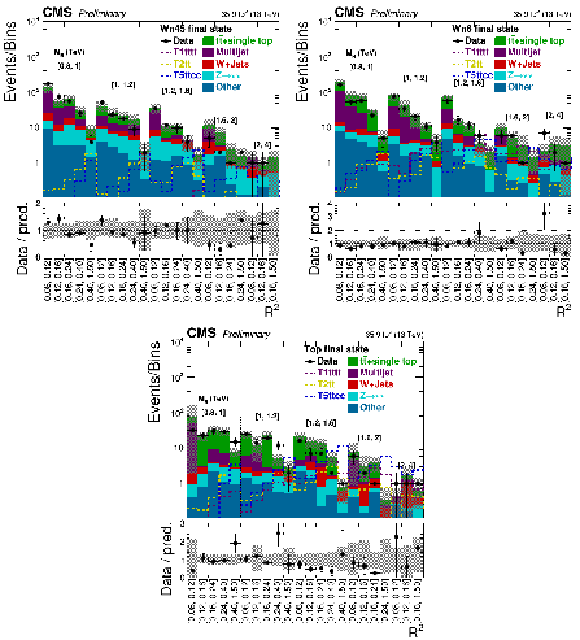
png pdf |
Figure 17:
The $ {M_\mathrm {R}} $-$ {\mathrm {R}^2} $ distribution observed in data is shown along with the background prediction obtained for the boosted Wnj45 (upper left), Wnj6 (upper right), and Top (bottom) categories. The two-dimensional $ {M_\mathrm {R}} $-$ {\mathrm {R}^2} $ distribution is shown in a one dimensional representation.The ratio of data to the background prediction is shown on the bottom inset, with the statistical uncertainty expressed through the data point error bars and the systematic uncertainty of the background prediction represented by the shaded region. Signal benchmarks shown are T5ttcc with $m_{\tilde{\mathrm{g}}} = $ 1.4 TeV, $m_{\tilde{\mathrm{t}}} = $ 320 GeV and $m_{\tilde{\chi}_1^0} = $ 300 GeV; T1tttt with $m_{\tilde{\mathrm{g}}} = $ 1.4 TeV and $m_{\tilde{\chi}_1^0} = $ 300 GeV; and T2tt with $m_{\tilde{\mathrm{t}}} = $ 850 GeV and $m_{\tilde{\chi}_1^0} = $ 100 GeV. The diagrams corresponding to these signal models are shown in Figure xxxxx. |
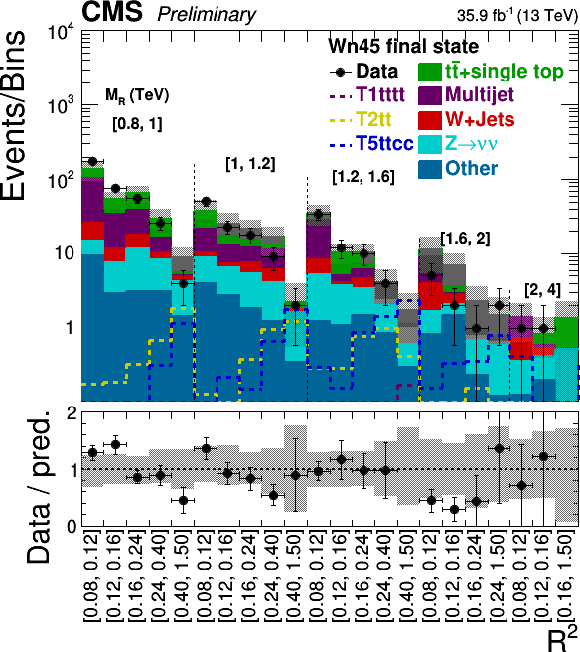
png |
Figure 17-a:
The $ {M_\mathrm {R}} $-$ {\mathrm {R}^2} $ distribution observed in data is shown along with the background prediction obtained for the boosted Wnj45 (upper left), Wnj6 (upper right), and Top (bottom) categories. The two-dimensional $ {M_\mathrm {R}} $-$ {\mathrm {R}^2} $ distribution is shown in a one dimensional representation.The ratio of data to the background prediction is shown on the bottom inset, with the statistical uncertainty expressed through the data point error bars and the systematic uncertainty of the background prediction represented by the shaded region. Signal benchmarks shown are T5ttcc with $m_{\tilde{\mathrm{g}}} = $ 1.4 TeV, $m_{\tilde{\mathrm{t}}} = $ 320 GeV and $m_{\tilde{\chi}_1^0} = $ 300 GeV; T1tttt with $m_{\tilde{\mathrm{g}}} = $ 1.4 TeV and $m_{\tilde{\chi}_1^0} = $ 300 GeV; and T2tt with $m_{\tilde{\mathrm{t}}} = $ 850 GeV and $m_{\tilde{\chi}_1^0} = $ 100 GeV. The diagrams corresponding to these signal models are shown in Figure xxxxx.-a |

png |
Figure 17-b:
The $ {M_\mathrm {R}} $-$ {\mathrm {R}^2} $ distribution observed in data is shown along with the background prediction obtained for the boosted Wnj45 (upper left), Wnj6 (upper right), and Top (bottom) categories. The two-dimensional $ {M_\mathrm {R}} $-$ {\mathrm {R}^2} $ distribution is shown in a one dimensional representation.The ratio of data to the background prediction is shown on the bottom inset, with the statistical uncertainty expressed through the data point error bars and the systematic uncertainty of the background prediction represented by the shaded region. Signal benchmarks shown are T5ttcc with $m_{\tilde{\mathrm{g}}} = $ 1.4 TeV, $m_{\tilde{\mathrm{t}}} = $ 320 GeV and $m_{\tilde{\chi}_1^0} = $ 300 GeV; T1tttt with $m_{\tilde{\mathrm{g}}} = $ 1.4 TeV and $m_{\tilde{\chi}_1^0} = $ 300 GeV; and T2tt with $m_{\tilde{\mathrm{t}}} = $ 850 GeV and $m_{\tilde{\chi}_1^0} = $ 100 GeV. The diagrams corresponding to these signal models are shown in Figure xxxxx.-b |
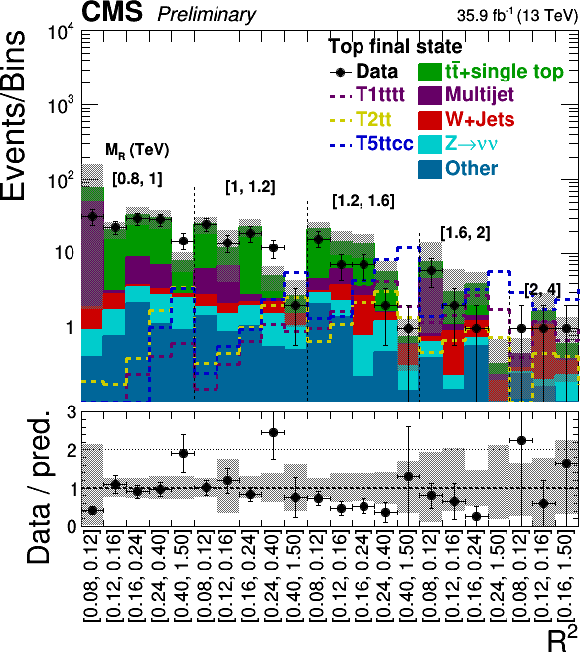
png |
Figure 17-c:
The $ {M_\mathrm {R}} $-$ {\mathrm {R}^2} $ distribution observed in data is shown along with the background prediction obtained for the boosted Wnj45 (upper left), Wnj6 (upper right), and Top (bottom) categories. The two-dimensional $ {M_\mathrm {R}} $-$ {\mathrm {R}^2} $ distribution is shown in a one dimensional representation.The ratio of data to the background prediction is shown on the bottom inset, with the statistical uncertainty expressed through the data point error bars and the systematic uncertainty of the background prediction represented by the shaded region. Signal benchmarks shown are T5ttcc with $m_{\tilde{\mathrm{g}}} = $ 1.4 TeV, $m_{\tilde{\mathrm{t}}} = $ 320 GeV and $m_{\tilde{\chi}_1^0} = $ 300 GeV; T1tttt with $m_{\tilde{\mathrm{g}}} = $ 1.4 TeV and $m_{\tilde{\chi}_1^0} = $ 300 GeV; and T2tt with $m_{\tilde{\mathrm{t}}} = $ 850 GeV and $m_{\tilde{\chi}_1^0} = $ 100 GeV. The diagrams corresponding to these signal models are shown in Figure xxxxx.-c |

png pdf |
Figure 18:
The $ {M_\mathrm {R}} $-$ {\mathrm {R}^2} $ distribution observed in data is shown along with the background prediction obtained for the Dijet event category in the 0 b-tag (top) and 1 b-tag (bottom) bins. The two-dimensional $ {M_\mathrm {R}} $-$ {\mathrm {R}^2} $ distribution is shown in a one dimensional representation, with each $ {M_\mathrm {R}} $ bin marked by the dashed lines and labeled near the top, and each $ {\mathrm {R}^2} $ bin labeled below. The ratio of data to the background prediction is shown on the bottom inset, with the statistical uncertainty expressed through the data point error bars and the systematic uncertainty of the background prediction represented by the shaded region. Signal benchmarks shown are T5ttcc with $m_{\tilde{\mathrm{g}}} = $ 1.4 TeV, $m_{\tilde{\mathrm{t}}} = $ 320 GeV and $m_{\tilde{\chi}_1^0} = $ 300 GeV; T1tttt with $m_{\tilde{\mathrm{g}}} = $ 1.4 TeV and $m_{\tilde{\chi}_1^0} = $ 300 GeV; and T2tt with $m_{\tilde{\mathrm{t}}} = $ 850 GeV and $m_{\tilde{\chi}_1^0} = $ 100 GeV. The diagrams corresponding to these signal models are shown in Figure xxxxx. |
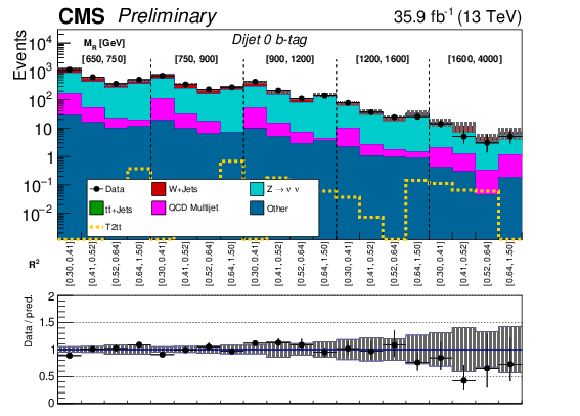
png pdf |
Figure 18-a:
The $ {M_\mathrm {R}} $-$ {\mathrm {R}^2} $ distribution observed in data is shown along with the background prediction obtained for the Dijet event category in the 0 b-tag (top) and 1 b-tag (bottom) bins. The two-dimensional $ {M_\mathrm {R}} $-$ {\mathrm {R}^2} $ distribution is shown in a one dimensional representation, with each $ {M_\mathrm {R}} $ bin marked by the dashed lines and labeled near the top, and each $ {\mathrm {R}^2} $ bin labeled below. The ratio of data to the background prediction is shown on the bottom inset, with the statistical uncertainty expressed through the data point error bars and the systematic uncertainty of the background prediction represented by the shaded region. Signal benchmarks shown are T5ttcc with $m_{\tilde{\mathrm{g}}} = $ 1.4 TeV, $m_{\tilde{\mathrm{t}}} = $ 320 GeV and $m_{\tilde{\chi}_1^0} = $ 300 GeV; T1tttt with $m_{\tilde{\mathrm{g}}} = $ 1.4 TeV and $m_{\tilde{\chi}_1^0} = $ 300 GeV; and T2tt with $m_{\tilde{\mathrm{t}}} = $ 850 GeV and $m_{\tilde{\chi}_1^0} = $ 100 GeV. The diagrams corresponding to these signal models are shown in Figure xxxxx.-a |

png pdf |
Figure 18-b:
The $ {M_\mathrm {R}} $-$ {\mathrm {R}^2} $ distribution observed in data is shown along with the background prediction obtained for the Dijet event category in the 0 b-tag (top) and 1 b-tag (bottom) bins. The two-dimensional $ {M_\mathrm {R}} $-$ {\mathrm {R}^2} $ distribution is shown in a one dimensional representation, with each $ {M_\mathrm {R}} $ bin marked by the dashed lines and labeled near the top, and each $ {\mathrm {R}^2} $ bin labeled below. The ratio of data to the background prediction is shown on the bottom inset, with the statistical uncertainty expressed through the data point error bars and the systematic uncertainty of the background prediction represented by the shaded region. Signal benchmarks shown are T5ttcc with $m_{\tilde{\mathrm{g}}} = $ 1.4 TeV, $m_{\tilde{\mathrm{t}}} = $ 320 GeV and $m_{\tilde{\chi}_1^0} = $ 300 GeV; T1tttt with $m_{\tilde{\mathrm{g}}} = $ 1.4 TeV and $m_{\tilde{\chi}_1^0} = $ 300 GeV; and T2tt with $m_{\tilde{\mathrm{t}}} = $ 850 GeV and $m_{\tilde{\chi}_1^0} = $ 100 GeV. The diagrams corresponding to these signal models are shown in Figure xxxxx.-b |

png pdf |
Figure 19:
The $ {M_\mathrm {R}} $-$ {\mathrm {R}^2} $ distribution observed in data is shown along with the background prediction obtained for the Dijet event category in the 2 b-tag bin. The two-dimensional $ {M_\mathrm {R}} $-$ {\mathrm {R}^2} $ distribution is shown in a one dimensional representation, with each $ {M_\mathrm {R}} $ bin marked by the dashed lines and labeled near the top, and each $ {\mathrm {R}^2} $ bin labeled below. The ratio of data to the background prediction is shown on the bottom inset, with the statistical uncertainty expressed through the data point error bars and the systematic uncertainty of the background prediction represented by the shaded region. Signal benchmarks shown are T5ttcc with $m_{\tilde{\mathrm{g}}} = $ 1.4 TeV, $m_{\tilde{\mathrm{t}}} = $ 320 GeV and $m_{\tilde{\chi}_1^0} = $ 300 GeV; T1tttt with $m_{\tilde{\mathrm{g}}} = $ 1.4 TeV and $m_{\tilde{\chi}_1^0} = $ 300 GeV; and T2tt with $m_{\tilde{\mathrm{t}}} = $ 850 GeV and $m_{\tilde{\chi}_1^0} = $ 100 GeV. The diagrams corresponding to these signal models are shown in Figure xxxxx. |
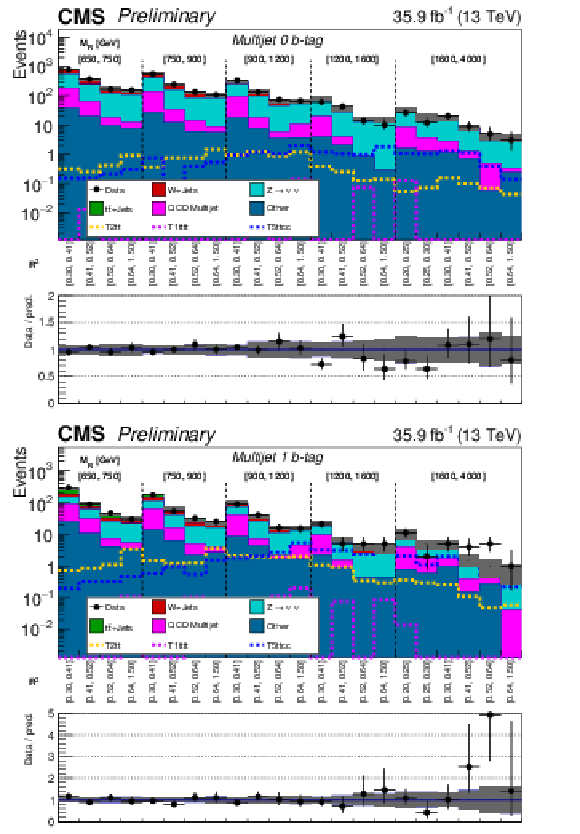
png pdf |
Figure 20:
The $ {M_\mathrm {R}} $-$ {\mathrm {R}^2} $ distribution observed in data is shown along with the background prediction obtained for the Multijet event category in the 0 b-tag (top) and 1 b-tag (bottom) bins. The two-dimensional $ {M_\mathrm {R}} $-$ {\mathrm {R}^2} $ distribution is shown in a one dimensional representation, with each $ {M_\mathrm {R}} $ bin marked by the dashed lines and labeled near the top, and each $ {\mathrm {R}^2} $ bin labeled below. The ratio of data to the background prediction is shown on the bottom inset, with the statistical uncertainty expressed through the data point error bars and the systematic uncertainty of the background prediction represented by the shaded region. Signal benchmarks shown are T5ttcc with $m_{\tilde{\mathrm{g}}} = $ 1.4 TeV, $m_{\tilde{\mathrm{t}}} = $ 320 GeV and $m_{\tilde{\chi}_1^0} = $ 300 GeV; T1tttt with $m_{\tilde{\mathrm{g}}} = $ 1.4 TeV and $m_{\tilde{\chi}_1^0} = $ 300 GeV; and T2tt with $m_{\tilde{\mathrm{t}}} = $ 850 GeV and $m_{\tilde{\chi}_1^0} = $ 100 GeV. The diagrams corresponding to these signal models are shown in Figure xxxxx. |
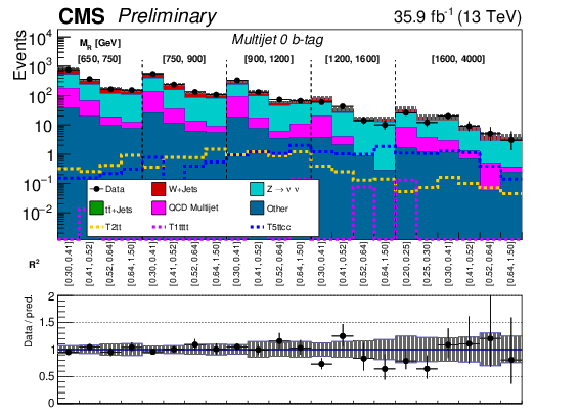
png pdf |
Figure 20-a:
The $ {M_\mathrm {R}} $-$ {\mathrm {R}^2} $ distribution observed in data is shown along with the background prediction obtained for the Multijet event category in the 0 b-tag (top) and 1 b-tag (bottom) bins. The two-dimensional $ {M_\mathrm {R}} $-$ {\mathrm {R}^2} $ distribution is shown in a one dimensional representation, with each $ {M_\mathrm {R}} $ bin marked by the dashed lines and labeled near the top, and each $ {\mathrm {R}^2} $ bin labeled below. The ratio of data to the background prediction is shown on the bottom inset, with the statistical uncertainty expressed through the data point error bars and the systematic uncertainty of the background prediction represented by the shaded region. Signal benchmarks shown are T5ttcc with $m_{\tilde{\mathrm{g}}} = $ 1.4 TeV, $m_{\tilde{\mathrm{t}}} = $ 320 GeV and $m_{\tilde{\chi}_1^0} = $ 300 GeV; T1tttt with $m_{\tilde{\mathrm{g}}} = $ 1.4 TeV and $m_{\tilde{\chi}_1^0} = $ 300 GeV; and T2tt with $m_{\tilde{\mathrm{t}}} = $ 850 GeV and $m_{\tilde{\chi}_1^0} = $ 100 GeV. The diagrams corresponding to these signal models are shown in Figure xxxxx.-a |
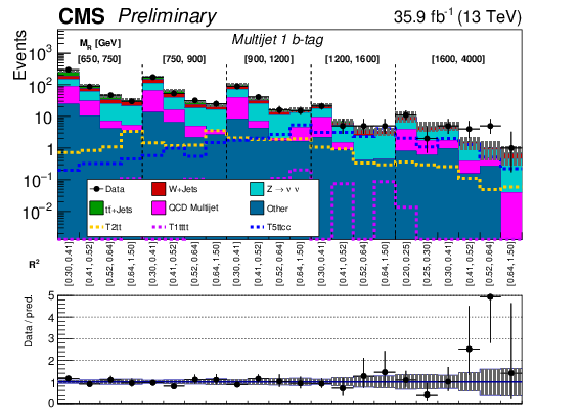
png pdf |
Figure 20-b:
The $ {M_\mathrm {R}} $-$ {\mathrm {R}^2} $ distribution observed in data is shown along with the background prediction obtained for the Multijet event category in the 0 b-tag (top) and 1 b-tag (bottom) bins. The two-dimensional $ {M_\mathrm {R}} $-$ {\mathrm {R}^2} $ distribution is shown in a one dimensional representation, with each $ {M_\mathrm {R}} $ bin marked by the dashed lines and labeled near the top, and each $ {\mathrm {R}^2} $ bin labeled below. The ratio of data to the background prediction is shown on the bottom inset, with the statistical uncertainty expressed through the data point error bars and the systematic uncertainty of the background prediction represented by the shaded region. Signal benchmarks shown are T5ttcc with $m_{\tilde{\mathrm{g}}} = $ 1.4 TeV, $m_{\tilde{\mathrm{t}}} = $ 320 GeV and $m_{\tilde{\chi}_1^0} = $ 300 GeV; T1tttt with $m_{\tilde{\mathrm{g}}} = $ 1.4 TeV and $m_{\tilde{\chi}_1^0} = $ 300 GeV; and T2tt with $m_{\tilde{\mathrm{t}}} = $ 850 GeV and $m_{\tilde{\chi}_1^0} = $ 100 GeV. The diagrams corresponding to these signal models are shown in Figure xxxxx.-b |

png pdf |
Figure 21:
The $ {M_\mathrm {R}} $-$ {\mathrm {R}^2} $ distribution observed in data is shown along with the background prediction obtained for the Multijet event category in the 2 b-tag (top) and 3 b-tag (bottom) bins. The two-dimensional $ {M_\mathrm {R}} $-$ {\mathrm {R}^2} $ distribution is shown in a one dimensional representation, with each $ {M_\mathrm {R}} $ bin marked by the dashed lines and labeled near the top, and each $ {\mathrm {R}^2} $ bin labeled below. The ratio of data to the background prediction is shown on the bottom inset, with the statistical uncertainty expressed through the data point error bars and the systematic uncertainty of the background prediction represented by the shaded region. Signal benchmarks shown are T5ttcc with $m_{\tilde{\mathrm{g}}} = $ 1.4 TeV, $m_{\tilde{\mathrm{t}}} = $ 320 GeV and $m_{\tilde{\chi}_1^0} = $ 300 GeV; T1tttt with $m_{\tilde{\mathrm{g}}} = $ 1.4 TeV and $m_{\tilde{\chi}_1^0} = $ 300 GeV; and T2tt with $m_{\tilde{\mathrm{t}}} = $ 850 GeV and $m_{\tilde{\chi}_1^0} = $ 100 GeV. The diagrams corresponding to these signal models are shown in Figure xxxxx. |
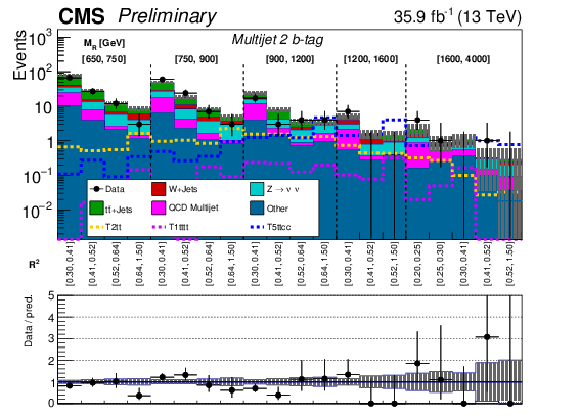
png pdf |
Figure 21-a:
The $ {M_\mathrm {R}} $-$ {\mathrm {R}^2} $ distribution observed in data is shown along with the background prediction obtained for the Multijet event category in the 2 b-tag (top) and 3 b-tag (bottom) bins. The two-dimensional $ {M_\mathrm {R}} $-$ {\mathrm {R}^2} $ distribution is shown in a one dimensional representation, with each $ {M_\mathrm {R}} $ bin marked by the dashed lines and labeled near the top, and each $ {\mathrm {R}^2} $ bin labeled below. The ratio of data to the background prediction is shown on the bottom inset, with the statistical uncertainty expressed through the data point error bars and the systematic uncertainty of the background prediction represented by the shaded region. Signal benchmarks shown are T5ttcc with $m_{\tilde{\mathrm{g}}} = $ 1.4 TeV, $m_{\tilde{\mathrm{t}}} = $ 320 GeV and $m_{\tilde{\chi}_1^0} = $ 300 GeV; T1tttt with $m_{\tilde{\mathrm{g}}} = $ 1.4 TeV and $m_{\tilde{\chi}_1^0} = $ 300 GeV; and T2tt with $m_{\tilde{\mathrm{t}}} = $ 850 GeV and $m_{\tilde{\chi}_1^0} = $ 100 GeV. The diagrams corresponding to these signal models are shown in Figure xxxxx.-a |
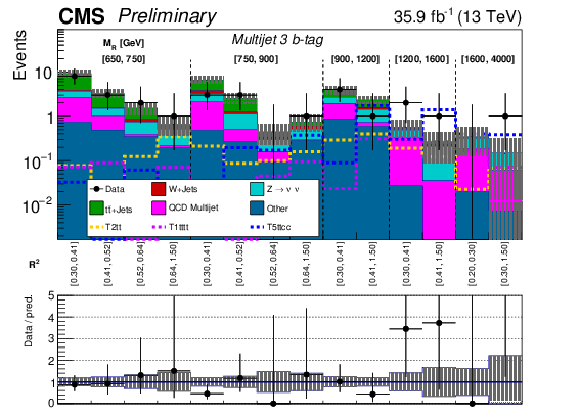
png pdf |
Figure 21-b:
The $ {M_\mathrm {R}} $-$ {\mathrm {R}^2} $ distribution observed in data is shown along with the background prediction obtained for the Multijet event category in the 2 b-tag (top) and 3 b-tag (bottom) bins. The two-dimensional $ {M_\mathrm {R}} $-$ {\mathrm {R}^2} $ distribution is shown in a one dimensional representation, with each $ {M_\mathrm {R}} $ bin marked by the dashed lines and labeled near the top, and each $ {\mathrm {R}^2} $ bin labeled below. The ratio of data to the background prediction is shown on the bottom inset, with the statistical uncertainty expressed through the data point error bars and the systematic uncertainty of the background prediction represented by the shaded region. Signal benchmarks shown are T5ttcc with $m_{\tilde{\mathrm{g}}} = $ 1.4 TeV, $m_{\tilde{\mathrm{t}}} = $ 320 GeV and $m_{\tilde{\chi}_1^0} = $ 300 GeV; T1tttt with $m_{\tilde{\mathrm{g}}} = $ 1.4 TeV and $m_{\tilde{\chi}_1^0} = $ 300 GeV; and T2tt with $m_{\tilde{\mathrm{t}}} = $ 850 GeV and $m_{\tilde{\chi}_1^0} = $ 100 GeV. The diagrams corresponding to these signal models are shown in Figure xxxxx.-b |
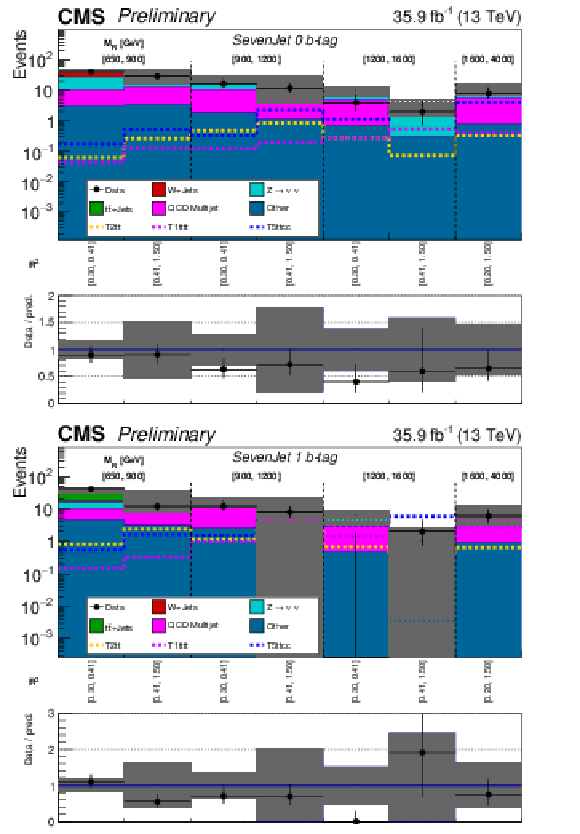
png pdf |
Figure 22:
The $ {M_\mathrm {R}} $-$ {\mathrm {R}^2} $ distribution observed in data is shown along with the background prediction obtained for the Seven-jet event category in the 0 b-tag (top) and 1 b-tag (bottom) bins. The two-dimensional $ {M_\mathrm {R}} $-$ {\mathrm {R}^2} $ distribution is shown in a one dimensional representation, with each $ {M_\mathrm {R}} $ bin marked by the dashed lines and labeled near the top, and each $ {\mathrm {R}^2} $ bin labeled below. The ratio of data to the background prediction is shown on the bottom inset, with the statistical uncertainty expressed through the data point error bars and the systematic uncertainty of the background prediction represented by the shaded region. Signal benchmarks shown are T5ttcc with $m_{\tilde{\mathrm{g}}} = $ 1.4 TeV, $m_{\tilde{\mathrm{t}}} = $ 320 GeV and $m_{\tilde{\chi}_1^0} = $ 300 GeV; T1tttt with $m_{\tilde{\mathrm{g}}} = $ 1.4 TeV and $m_{\tilde{\chi}_1^0} = $ 300 GeV; and T2tt with $m_{\tilde{\mathrm{t}}} = $ 850 GeV and $m_{\tilde{\chi}_1^0} = $ 100 GeV. The diagrams corresponding to these signal models are shown in Figure xxxxx. |

png pdf |
Figure 22-a:
The $ {M_\mathrm {R}} $-$ {\mathrm {R}^2} $ distribution observed in data is shown along with the background prediction obtained for the Seven-jet event category in the 0 b-tag (top) and 1 b-tag (bottom) bins. The two-dimensional $ {M_\mathrm {R}} $-$ {\mathrm {R}^2} $ distribution is shown in a one dimensional representation, with each $ {M_\mathrm {R}} $ bin marked by the dashed lines and labeled near the top, and each $ {\mathrm {R}^2} $ bin labeled below. The ratio of data to the background prediction is shown on the bottom inset, with the statistical uncertainty expressed through the data point error bars and the systematic uncertainty of the background prediction represented by the shaded region. Signal benchmarks shown are T5ttcc with $m_{\tilde{\mathrm{g}}} = $ 1.4 TeV, $m_{\tilde{\mathrm{t}}} = $ 320 GeV and $m_{\tilde{\chi}_1^0} = $ 300 GeV; T1tttt with $m_{\tilde{\mathrm{g}}} = $ 1.4 TeV and $m_{\tilde{\chi}_1^0} = $ 300 GeV; and T2tt with $m_{\tilde{\mathrm{t}}} = $ 850 GeV and $m_{\tilde{\chi}_1^0} = $ 100 GeV. The diagrams corresponding to these signal models are shown in Figure xxxxx.-a |

png pdf |
Figure 22-b:
The $ {M_\mathrm {R}} $-$ {\mathrm {R}^2} $ distribution observed in data is shown along with the background prediction obtained for the Seven-jet event category in the 0 b-tag (top) and 1 b-tag (bottom) bins. The two-dimensional $ {M_\mathrm {R}} $-$ {\mathrm {R}^2} $ distribution is shown in a one dimensional representation, with each $ {M_\mathrm {R}} $ bin marked by the dashed lines and labeled near the top, and each $ {\mathrm {R}^2} $ bin labeled below. The ratio of data to the background prediction is shown on the bottom inset, with the statistical uncertainty expressed through the data point error bars and the systematic uncertainty of the background prediction represented by the shaded region. Signal benchmarks shown are T5ttcc with $m_{\tilde{\mathrm{g}}} = $ 1.4 TeV, $m_{\tilde{\mathrm{t}}} = $ 320 GeV and $m_{\tilde{\chi}_1^0} = $ 300 GeV; T1tttt with $m_{\tilde{\mathrm{g}}} = $ 1.4 TeV and $m_{\tilde{\chi}_1^0} = $ 300 GeV; and T2tt with $m_{\tilde{\mathrm{t}}} = $ 850 GeV and $m_{\tilde{\chi}_1^0} = $ 100 GeV. The diagrams corresponding to these signal models are shown in Figure xxxxx.-b |

png pdf |
Figure 23:
The $ {M_\mathrm {R}} $-$ {\mathrm {R}^2} $ distribution observed in data is shown along with the background prediction obtained for the Seven-jet event category in the 2 b-tag (top) and 3 b-tag (bottom) bins. The two-dimensional $ {M_\mathrm {R}} $-$ {\mathrm {R}^2} $ distribution is shown in a one dimensional representation, with each $ {M_\mathrm {R}} $ bin marked by the dashed lines and labeled near the top, and each $ {\mathrm {R}^2} $ bin labeled below. The ratio of data to the background prediction is shown on the bottom inset, with the statistical uncertainty expressed through the data point error bars and the systematic uncertainty of the background prediction represented by the shaded region. Signal benchmarks shown are T5ttcc with $m_{\tilde{\mathrm{g}}} = $ 1.4 TeV, $m_{\tilde{\mathrm{t}}} = $ 320 GeV and $m_{\tilde{\chi}_1^0} = $ 300 GeV; T1tttt with $m_{\tilde{\mathrm{g}}} = $ 1.4 TeV and $m_{\tilde{\chi}_1^0} = $ 300 GeV; and T2tt with $m_{\tilde{\mathrm{t}}} = $ 850 GeV and $m_{\tilde{\chi}_1^0} = $ 100 GeV. The diagrams corresponding to these signal models are shown in Figure xxxxx. |
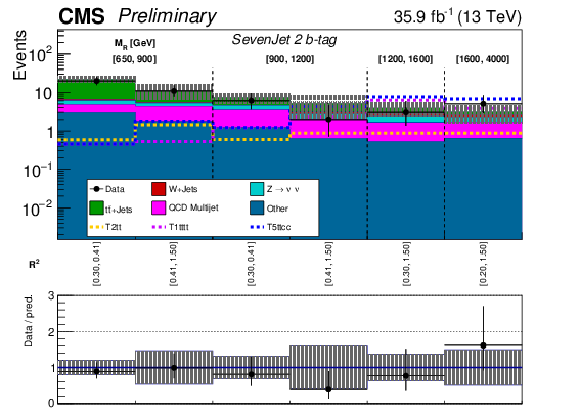
png pdf |
Figure 23-a:
The $ {M_\mathrm {R}} $-$ {\mathrm {R}^2} $ distribution observed in data is shown along with the background prediction obtained for the Seven-jet event category in the 2 b-tag (top) and 3 b-tag (bottom) bins. The two-dimensional $ {M_\mathrm {R}} $-$ {\mathrm {R}^2} $ distribution is shown in a one dimensional representation, with each $ {M_\mathrm {R}} $ bin marked by the dashed lines and labeled near the top, and each $ {\mathrm {R}^2} $ bin labeled below. The ratio of data to the background prediction is shown on the bottom inset, with the statistical uncertainty expressed through the data point error bars and the systematic uncertainty of the background prediction represented by the shaded region. Signal benchmarks shown are T5ttcc with $m_{\tilde{\mathrm{g}}} = $ 1.4 TeV, $m_{\tilde{\mathrm{t}}} = $ 320 GeV and $m_{\tilde{\chi}_1^0} = $ 300 GeV; T1tttt with $m_{\tilde{\mathrm{g}}} = $ 1.4 TeV and $m_{\tilde{\chi}_1^0} = $ 300 GeV; and T2tt with $m_{\tilde{\mathrm{t}}} = $ 850 GeV and $m_{\tilde{\chi}_1^0} = $ 100 GeV. The diagrams corresponding to these signal models are shown in Figure xxxxx.-a |
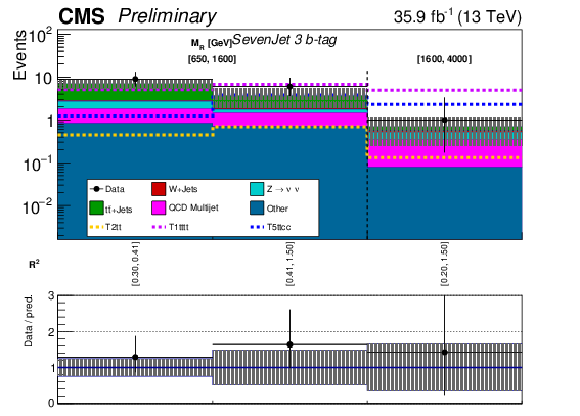
png pdf |
Figure 23-b:
The $ {M_\mathrm {R}} $-$ {\mathrm {R}^2} $ distribution observed in data is shown along with the background prediction obtained for the Seven-jet event category in the 2 b-tag (top) and 3 b-tag (bottom) bins. The two-dimensional $ {M_\mathrm {R}} $-$ {\mathrm {R}^2} $ distribution is shown in a one dimensional representation, with each $ {M_\mathrm {R}} $ bin marked by the dashed lines and labeled near the top, and each $ {\mathrm {R}^2} $ bin labeled below. The ratio of data to the background prediction is shown on the bottom inset, with the statistical uncertainty expressed through the data point error bars and the systematic uncertainty of the background prediction represented by the shaded region. Signal benchmarks shown are T5ttcc with $m_{\tilde{\mathrm{g}}} = $ 1.4 TeV, $m_{\tilde{\mathrm{t}}} = $ 320 GeV and $m_{\tilde{\chi}_1^0} = $ 300 GeV; T1tttt with $m_{\tilde{\mathrm{g}}} = $ 1.4 TeV and $m_{\tilde{\chi}_1^0} = $ 300 GeV; and T2tt with $m_{\tilde{\mathrm{t}}} = $ 850 GeV and $m_{\tilde{\chi}_1^0} = $ 100 GeV. The diagrams corresponding to these signal models are shown in Figure xxxxx.-b |

png pdf |
Figure 24:
Diagrams for the simplified models considered in this analysis: (left) Gluino pair production decaying to two top quarks and the LSP, denoted T1tttt; (middle) Gluino pair production decaying to a top quark and a low mass top squark, which subsequently decays to a charm quark and the LSP, denoted T5ttcc; (right) Top squark pair production decaying to a top quark and the LSP, denoted T2tt. |
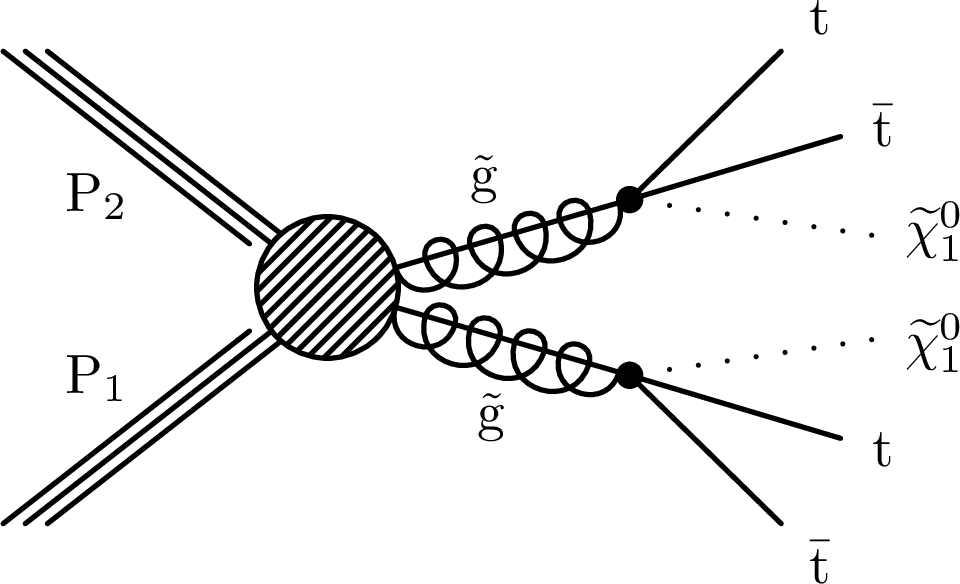
png pdf |
Figure 24-a:
Diagrams for the simplified models considered in this analysis: (left) Gluino pair production decaying to two top quarks and the LSP, denoted T1tttt; (middle) Gluino pair production decaying to a top quark and a low mass top squark, which subsequently decays to a charm quark and the LSP, denoted T5ttcc; (right) Top squark pair production decaying to a top quark and the LSP, denoted T2tt. |

png pdf |
Figure 24-b:
Diagrams for the simplified models considered in this analysis: (left) Gluino pair production decaying to two top quarks and the LSP, denoted T1tttt; (middle) Gluino pair production decaying to a top quark and a low mass top squark, which subsequently decays to a charm quark and the LSP, denoted T5ttcc; (right) Top squark pair production decaying to a top quark and the LSP, denoted T2tt. |
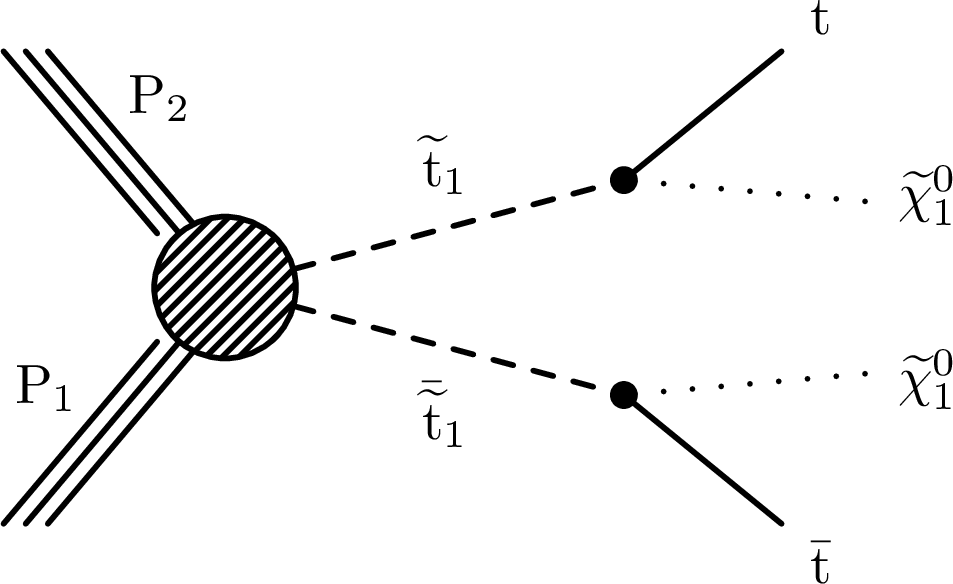
png pdf |
Figure 24-c:
Diagrams for the simplified models considered in this analysis: (left) Gluino pair production decaying to two top quarks and the LSP, denoted T1tttt; (middle) Gluino pair production decaying to a top quark and a low mass top squark, which subsequently decays to a charm quark and the LSP, denoted T5ttcc; (right) Top squark pair production decaying to a top quark and the LSP, denoted T2tt. |
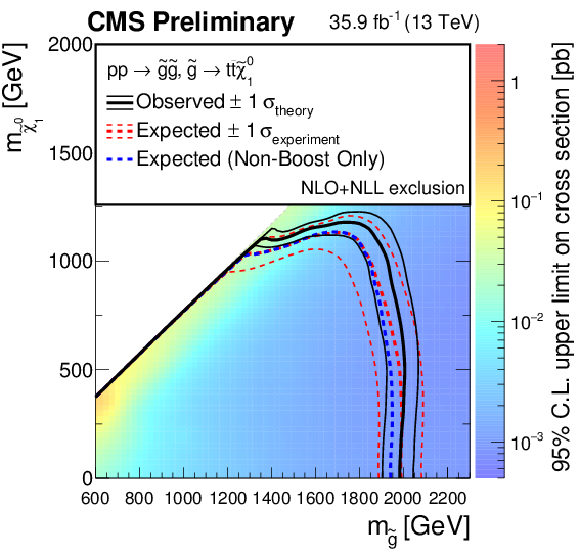
png pdf |
Figure 25:
Expected and observed 95% upper limits on the production cross section for pair-produced gluinos decaying to top quarks. The blue dotted contour represents the expected 95% upper limits using data in the nonboosted categories only. |
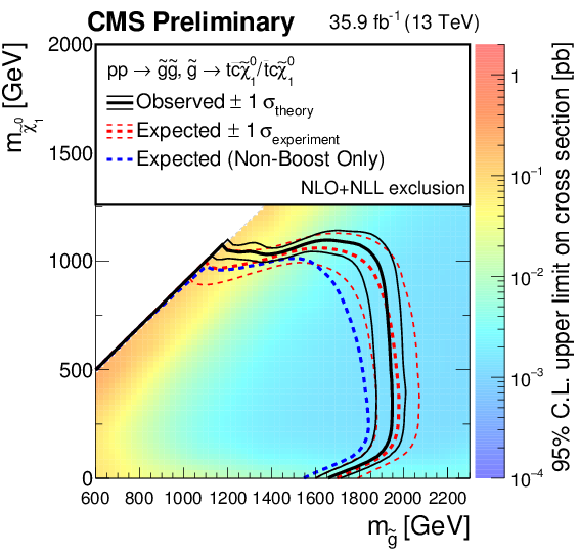
png pdf |
Figure 26:
Expected and observed 95% upper limit on the production cross section for pair-produced gluinos decaying to a top and a charm quark. The blue dotted contour represents the expected 95% upper limits using data in the nonboosted categories only. |

png pdf |
Figure 27:
Expected and observed 95% upper limits on the production cross section for pair-produced squarks decaying to top quarks. The blue dotted contour represents the expected 95% upper limits using data in the nonboosted categories only. The white diagonal band corresponds to the region $ | m_{\tilde{\mathrm{t}}}-m_{{\mathrm {t}}}-m_{\tilde{\chi}^{0} _1} | < $ 25 GeV, where the signal efficiency is a strong function of $m_{\tilde{\mathrm{t}}}-m_{\tilde{\chi}^{0} _1}$, and as a result the precise determination of the cross section upper limit is uncertain because of the finite granularity of the available MC samples in this region of the ($m_{\tilde{\mathrm{t}}}$, $m_{\tilde{\chi}^{0} _1}$) plane. |
| Tables | |
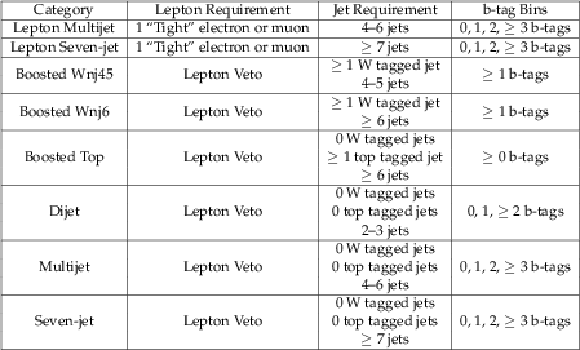
png pdf |
Table 1:
Summary of the search categories, their charged lepton and jet count requirements, and the b-tag bins that define the subcategories. Events passing the "Lepton Veto'' requirement must have no tight electron or muon, no veto electron or muon, and no hadronic taus. |
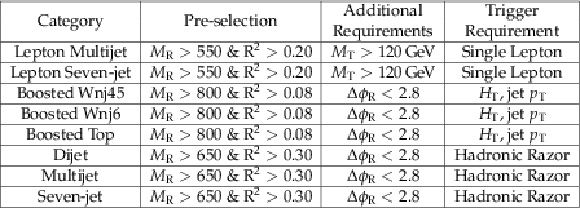
png pdf |
Table 2:
The baseline requirements on the razor variables $ {M_\mathrm {R}} $ and $ {\mathrm {R}^2} $, additional requirements on $M_{\mathrm {T}}$ and $ {\Delta \phi _\mathrm {R}} $, and the trigger requirements are shown for each event category. |

png pdf |
Table 3:
Summary of the main instrumental and theoretical systematic uncertainties. |
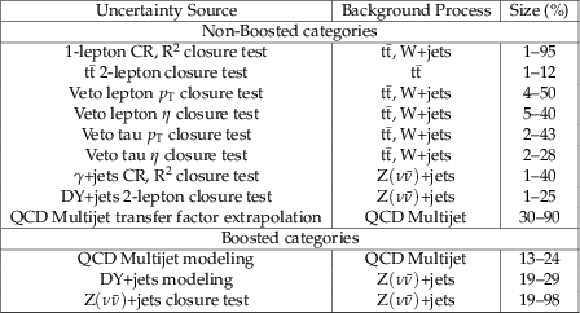
png pdf |
Table 4:
Summary of systematic uncertainties due to background estimation methodology expressed as relative or fractional uncertainties. |
| Summary |
|
We have presented an inclusive search for supersymmetry in events with no more than one lepton, a large multiplicity of energetic jets, and evidence of invisible particles using the razor kinematic variables. To enhance sensitivity to a broad range of signal models, the events are categorized according to the number of leptons, the presence of jets consistent with hadronically decaying W bosons or top quarks, and the number of jets and b-tagged jets. This analysis is the first inclusive search for supersymmetry from the CMS experiment that explicitly incorporates event categories with boosted W boson or top quark jets. The analysis uses 35.9 fb$^{-1}$ of $\sqrt{s}= $ 13 TeV proton-proton collision data collected by the CMS experiment. Standard model backgrounds were estimated using control regions in data and Monte Carlo simulation yields in signal and control regions. Background estimation procedures were verified using validation regions with kinematics resembling that of the signal regions and closure tests. Data are observed to be consistent with the SM expectation. The search is sensitive to a broad range of SUSY scenarios including pair production of gluinos and top squarks, and the event categorization in the number of leptons, the number of jets and b-tagged jets, and the presence or absence of boosted jets consistent with hadronic W or top decays, enhances the signal to background and search sensitivity simultaneously for a variety of different SUSY signal scenarios. The results were interpreted in the context of simplified models of gluino pair production decaying to various quark flavors, or direct top squark pair production. Limits on the gluino mass extend to $2.0$ TeV while limits on top squark masses reach $1.14$ TeV. The advantage of combining a large variety of final states enabled this analysis to improve the sensitivity in various signal scenarios. The analysis extended the exclusion limit of the gluino mass from the CMS experiment by $\sim $100 GeV in decays to a low mass top squark and a top quark, and the exclusion limit of the top squark mass by $\sim $20 GeV in direct top squark production. |
| References | ||||
| 1 | CMS Collaboration | Inclusive search for supersymmetry using razor variables in pp collisions at $ \sqrt s= $ 13 TeV | PRD 95 (2017) 012003 | CMS-SUS-15-004 1609.07658 |
| 2 | CMS Collaboration | Search for supersymmetry in pp collisions at $ \sqrt{s} = $ 8 TeV in final states with boosted W bosons and b jets using razor variables | PRD93 (2016) 092009 | CMS-SUS-14-007 1602.02917 |
| 3 | J. Wess and B. Zumino | Supergauge transformations in four dimensions | NPB 70 (1974) 39 | |
| 4 | Y. A. Gol'fand and E. P. Likhtman | Extension of the algebra of poincare group generators and violation of P invariance | JEPTL 13 (1971) 323 | |
| 5 | D. V. Volkov and V. P. Akulov | Possible universal neutrino interaction | JEPTL 16 (1972) 438 | |
| 6 | A. H. Chamseddine, R. L. Arnowitt, and P. Nath | Locally supersymmetric grand unification | PRL 49 (1982) 970 | |
| 7 | G. L. Kane, C. F. Kolda, L. Roszkowski, and J. D. Wells | Study of constrained minimal supersymmetry | PRD 49 (1994) 6173 | hep-ph/9312272 |
| 8 | P. Fayet | Supergauge invariant extension of the Higgs mechanism and a model for the electron and its neutrino | NPB 90 (1975) 104 | |
| 9 | R. Barbieri, S. Ferrara, and C. A. Savoy | Gauge models with spontaneously broken local supersymmetry | PLB 119 (1982) 343 | |
| 10 | L. J. Hall, J. D. Lykken, and S. Weinberg | Supergravity as the messenger of supersymmetry breaking | PRD 27 (1983) 2359 | |
| 11 | P. Ramond | Dual theory for free fermions | PRD 3 (1971) 2415 | |
| 12 | E. Witten | Dynamical Breaking of Supersymmetry | NPB188 (1981) 513 | |
| 13 | S. Dimopoulos and H. Georgi | Softly Broken Supersymmetry and SU(5) | NPB193 (1981) 150 | |
| 14 | M. Dine, W. Fischler, and M. Srednicki | Supersymmetric Technicolor | NPB189 (1981) 575--593 | |
| 15 | S. Dimopoulos and S. Raby | Supercolor | NPB192 (1981) 353 | |
| 16 | N. Sakai | Naturalness in Supersymmetric Guts | Z. Phys. C11 (1981) 153 | |
| 17 | R. K. Kaul and P. Majumdar | Cancellation of Quadratically Divergent Mass Corrections in Globally Supersymmetric Spontaneously Broken Gauge Theories | NPB199 (1982) 36 | |
| 18 | S. Dimopoulos, S. Raby, and F. Wilczek | Supersymmetry and the Scale of Unification | PRD24 (1981) 1681--1683 | |
| 19 | W. J. Marciano and G. Senjanovic | Predictions of Supersymmetric Grand Unified Theories | PRD25 (1982) 3092 | |
| 20 | M. B. Einhorn and D. R. T. Jones | The Weak Mixing Angle and Unification Mass in Supersymmetric SU(5) | NPB196 (1982) 475 | |
| 21 | L. E. Ibanez and G. G. Ross | Low-Energy Predictions in Supersymmetric Grand Unified Theories | PLB105 (1981) 439 | |
| 22 | U. Amaldi, W. de Boer, and H. Furstenau | Comparison of grand unified theories with electroweak and strong coupling constants measured at LEP | PLB260 (1991) 447--455 | |
| 23 | P. Langacker and N. Polonsky | The Strong coupling, unification, and recent data | PRD52 (1995) 3081--3086 | hep-ph/9503214 |
| 24 | J. R. Ellis et al. | Supersymmetric Relics from the Big Bang | NPB238 (1984) 453--476 | |
| 25 | G. Jungman, M. Kamionkowski, and K. Griest | Supersymmetric dark matter | PR 267 (1996) 195--373 | hep-ph/9506380 |
| 26 | CMS Collaboration | Search for natural and split supersymmetry in proton-proton collisions at $ \sqrt{s}= $ 13 TeV in final states with jets and missing transverse momentum | JHEP 05 (2018) 025 | CMS-SUS-16-038 1802.02110 |
| 27 | CMS Collaboration | Search for top squark pair production in pp collisions at $ \sqrt{s}= $ 13 TeV using single lepton events | JHEP 10 (2017) 019 | CMS-SUS-16-051 1706.04402 |
| 28 | CMS Collaboration | Search for new phenomena with the $ M_{\mathrm {T2}} $ variable in the all-hadronic final state produced in proton-proton collisions at $ \sqrt{s} = $ 13 TeV | EPJC77 (2017) 710 | CMS-SUS-16-036 1705.04650 |
| 29 | CMS Collaboration | Search for Supersymmetry in $ pp $ Collisions at $ \sqrt{s}= $ 13 TeV in the Single-Lepton Final State Using the Sum of Masses of Large-Radius Jets | PRL 119 (2017) 151802 | CMS-SUS-16-037 1705.04673 |
| 30 | CMS Collaboration | Search for supersymmetry in multijet events with missing transverse momentum in proton-proton collisions at 13 TeV | PRD96 (2017) 032003 | CMS-SUS-16-033 1704.07781 |
| 31 | CMS Collaboration | Search for physics beyond the standard model in events with two leptons of same sign, missing transverse momentum, and jets in proton-proton collisions at $ \sqrt{s} = $ 13 TeV | EPJC77 (2017) 578 | CMS-SUS-16-035 1704.07323 |
| 32 | CMS Collaboration | Search for supersymmetry in the all-hadronic final state using top quark tagging in pp collisions at $ \sqrt{s} = $ 13 TeV | PRD96 (2017) 012004 | CMS-SUS-16-009 1701.01954 |
| 33 | CMS Collaboration | Searches for pair production of third-generation squarks in $ \sqrt{s}= $ 13 TeV pp collisions | EPJC77 (2017) 327 | CMS-SUS-16-008 1612.03877 |
| 34 | ATLAS Collaboration | Search for a scalar partner of the top quark in the jets plus missing transverse momentum final state at $ \sqrt{s}= $ 13 TeV with the ATLAS detector | JHEP 12 (2017) 085 | 1709.04183 |
| 35 | ATLAS Collaboration | Search for supersymmetry in events with $ b $-tagged jets and missing transverse momentum in $ pp $ collisions at $ \sqrt{s}= $ 13 TeV with the ATLAS detector | JHEP 11 (2017) 195 | 1708.09266 |
| 36 | ATLAS Collaboration | Search for squarks and gluinos in events with an isolated lepton, jets, and missing transverse momentum at $ \sqrt{s}= $ 13 TeV with the ATLAS detector | PRD96 (2017) 112010 | 1708.08232 |
| 37 | ATLAS Collaboration | Search for direct top squark pair production in final states with two leptons in $ \sqrt{s} = 13 TeV pp $ collisions with the ATLAS detector | EPJC77 (2017) 898 | 1708.03247 |
| 38 | ATLAS Collaboration | Search for new phenomena with large jet multiplicities and missing transverse momentum using large-radius jets and flavour-tagging at ATLAS in 13 $ TeV pp $ collisions | JHEP 12 (2017) 034 | 1708.02794 |
| 39 | ATLAS Collaboration | Search for supersymmetry in final states with two same-sign or three leptons and jets using 36 fb$ ^{-1} $ of $ \sqrt{s}=13 TeV pp $ collision data with the ATLAS detector | JHEP 09 (2017) 084 | 1706.03731 |
| 40 | ATLAS Collaboration | Search for new phenomena in a lepton plus high jet multiplicity final state with the ATLAS experiment using $ \sqrt{s}= $ 13 TeV proton-proton collision data | JHEP 09 (2017) 088 | 1704.08493 |
| 41 | CMS Collaboration | The CMS experiment at the CERN LHC | JINST 3 (2008) S08004 | CMS-00-001 |
| 42 | CMS Collaboration | Particle-flow reconstruction and global event description with the CMS detector | JINST 12 (2017) P10003 | CMS-PRF-14-001 1706.04965 |
| 43 | M. Cacciari, G. P. Salam, and G. Soyez | The anti-$ k_t $ jet clustering algorithm | JHEP 04 (2008) 063 | 0802.1189 |
| 44 | M. Cacciari, G. P. Salam, and G. Soyez | FastJet user manual | EPJC 72 (2012) 1896 | 1111.6097 |
| 45 | CMS Collaboration | Identification of heavy-flavour jets with the CMS detector in pp collisions at 13 TeV | JINST 13 (2018) P05011 | CMS-BTV-16-002 1712.07158 |
| 46 | J. Thaler and K. Van Tilburg | Identifying boosted objects with N-subjettiness | JHEP 03 (2011) 015 | 1011.2268 |
| 47 | A. J. Larkoski, S. Marzani, G. Soyez, and J. Thaler | Soft Drop | JHEP 05 (2014) 146 | 1402.2657 |
| 48 | CMS Collaboration | Performance of Electron Reconstruction and Selection with the CMS Detector in Proton-Proton Collisions at 8 TeV | JINST 10 (2015) P06005 | CMS-EGM-13-001 1502.02701 |
| 49 | CMS Collaboration | Performance of CMS muon reconstruction in $ pp $ collision events at $ \sqrt{s}= $ 7 TeV | JINST 7 (2012) P10002 | CMS-MUO-10-004 1206.4071 |
| 50 | CMS Collaboration | Reconstruction and identification of $ \tau $ lepton decays to hadrons and $ \nu_{\tau} $ at CMS | JINST 11 (2016) P01019 | CMS-TAU-14-001 1510.07488 |
| 51 | CMS Collaboration | Performance of photon reconstruction and identification with the CMS detector in proton-proton collisions at $ \sqrt{s} = $ 8 TeV | JINST 10 (2015) P08010 | CMS-EGM-14-001 1502.02702 |
| 52 | J. Alwall et al. | MadGraph5: going beyond | JHEP 06 (2011) 128 | 1106.0522 |
| 53 | T. Sjostrand, S. Mrenna, and P. Z. Skands | A Brief Introduction to PYTHIA 8.1 | CPC 178 (2008) 852--867 | 0710.3820 |
| 54 | T. Sjostrand et al. | An Introduction to PYTHIA 8.2 | CPC 191 (2015) 159--177 | 1410.3012 |
| 55 | S. Hoeche et al. | Matching parton showers and matrix elements | in HERA and the LHC: A Workshop on the implications of HERA for LHC physics: Proceedings Part A, pp. 288--289 2005 | hep-ph/0602031 |
| 56 | J. Alwall et al. | Comparative study of various algorithms for the merging of parton showers and matrix elements in hadronic collisions | EPJC53 (2008) 473--500 | 0706.2569 |
| 57 | J. Alwall et al. | The automated computation of tree-level and next-to-leading order differential cross sections, and their matching to parton shower simulations | JHEP 07 (2014) 079 | 1405.0301 |
| 58 | S. Frixione, P. Nason, and G. Ridolfi | A Positive-weight next-to-leading-order Monte Carlo for heavy flavour hadroproduction | JHEP 09 (2007) 126 | 0707.3088 |
| 59 | S. Alioli, P. Nason, C. Oleari, and E. Re | NLO single-top production matched with shower in POWHEG: s- and t-channel contributions | JHEP 09 (2009) 111 | 0907.4076 |
| 60 | E. Re | Single-top Wt-channel production matched with parton showers using the POWHEG method | EPJC71 (2011) 1547 | 1009.2450 |
| 61 | S. Agostinelli et al. | Geant4 - a simulation toolkit | NIMA 506 (2003) 250 -- 303 | |
| 62 | CMS Collaboration | The fast simulation of the CMS detector at LHC | J. Phys.: Conf. Ser. 331 (2011) 032049 | |
| 63 | W. Beenakker, R. Hopker, M. Spira, and P. M. Zerwas | Squark and gluino production at hadron colliders | NPB 492 (1997) 51 | hep-ph/9610490 |
| 64 | A. Kulesza and L. Motyka | Threshold resummation for squark-antisquark and gluino-pair production at the LHC | PRL 102 (2009) 111802 | 0807.2405 |
| 65 | A. Kulesza and L. Motyka | Soft gluon resummation for the production of gluino-gluino and squark-antisquark pairs at the LHC | PRD 80 (2009) 095004 | 0905.4749 |
| 66 | W. Beenakker et al. | Soft-gluon resummation for squark and gluino hadroproduction | JHEP 12 (2009) 041 | 0909.4418 |
| 67 | W. Beenakker et al. | Squark and gluino hadroproduction | Int. J. Mod. Phys. A 26 (2011) 2637 | 1105.1110 |
| 68 | C. Borschensky et al. | Squark and gluino production cross sections in pp collisions at $ \sqrt{s}= $ 13, 14, 33 and 100 TeV | EPJC74 (2014) 3174 | 1407.5066 |
| 69 | M. Kramer et al. | Supersymmetry production cross sections in $ pp $ collisions at $ \sqrt{s}= $ 7 TeV | 1206.2892 | |
| 70 | CMS Collaboration | Inclusive search for squarks and gluinos in pp collisions at $ \sqrt{s} = $ 7 TeV | PRD 85 (2012) 012004 | CMS-SUS-10-009 1107.1279 |
| 71 | CMS Collaboration | Missing transverse energy performance of the CMS detector | JINST 6 (2011) P09001 | CMS-JME-10-009 1106.5048 |
| 72 | CMS Collaboration | Performance of the CMS missing transverse momentum reconstruction in pp data at $ \sqrt{s} = $ 8 TeV | JINST 10 (2015) P02006 | CMS-JME-13-003 1411.0511 |
| 73 | ATLAS and CMS Collaborations | Procedure for the LHC Higgs boson search combination in summer 2011 | CMS-NOTE-2011-005 | |
| 74 | CMS Collaboration | Search for supersymmetry in proton-proton collisions at 13 TeV using identified top quarks | PRD97 (2018) 012007 | CMS-SUS-16-050 1710.11188 |

|
Compact Muon Solenoid LHC, CERN |

|

|

|

|

|

|